How To Make Conceptual Framework (With Examples and Templates)
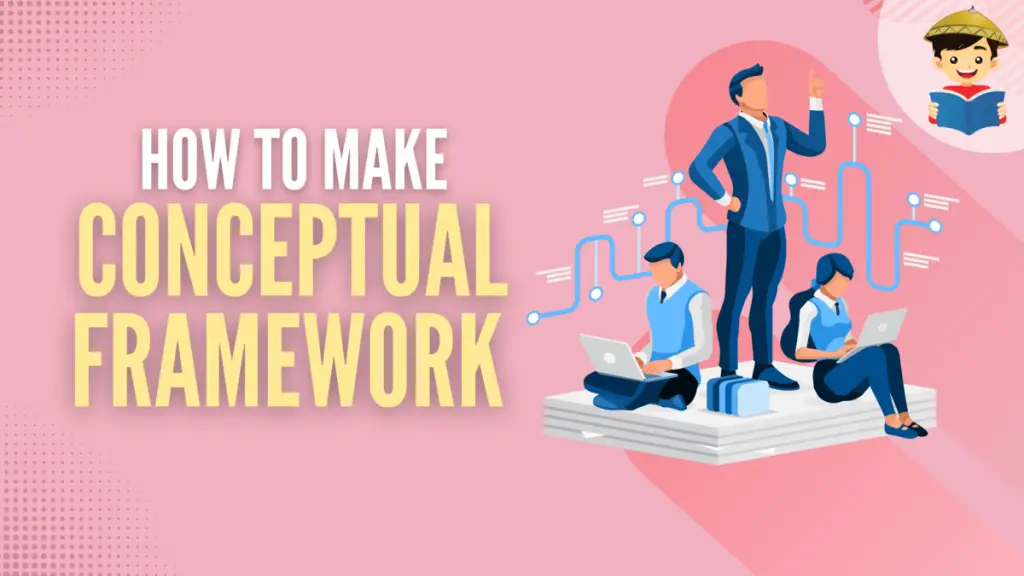
We all know that a research paper has plenty of concepts involved. However, a great deal of concepts makes your study confusing.
A conceptual framework ensures that the concepts of your study are organized and presented comprehensively. Let this article guide you on how to make the conceptual framework of your study.
Related: How to Write a Concept Paper for Academic Research

Table of Contents
At a glance: free conceptual framework templates.
Too busy to create a conceptual framework from scratch? No problem. We’ve created templates for each conceptual framework so you can start on the right foot. All you need to do is enter the details of the variables. Feel free to modify the design according to your needs. Please read the main article below to learn more about the conceptual framework.
Conceptual Framework Template #1: Independent-Dependent Variable Model
Conceptual framework template #2: input-process-output (ipo) model, conceptual framework template #3: concept map, what is a conceptual framework.
A conceptual framework shows the relationship between the variables of your study. It includes a visual diagram or a model that summarizes the concepts of your study and a narrative explanation of the model presented.
Why Should Research Be Given a Conceptual Framework?
Imagine your study as a long journey with the research result as the destination. You don’t want to get lost in your journey because of the complicated concepts. This is why you need to have a guide. The conceptual framework keeps you on track by presenting and simplifying the relationship between the variables. This is usually done through the use of illustrations that are supported by a written interpretation.
Also, people who will read your research must have a clear guide to the variables in your study and where the research is heading. By looking at the conceptual framework, the readers can get the gist of the research concepts without reading the entire study.
Related: How to Write Significance of the Study (with Examples)
What Is the Difference Between Conceptual Framework and Theoretical Framework?
Both of them show concepts and ideas of your study. The theoretical framework presents the theories, rules, and principles that serve as the basis of the research. Thus, the theoretical framework presents broad concepts related to your study. On the other hand, the conceptual framework shows a specific approach derived from the theoretical framework. It provides particular variables and shows how these variables are related.
Let’s say your research is about the Effects of Social Media on the Political Literacy of College Students. You may include some theories related to political literacy, such as this paper, in your theoretical framework. Based on this paper, political participation and awareness determine political literacy.
For the conceptual framework, you may state that the specific form of political participation and awareness you will use for the study is the engagement of college students on political issues on social media. Then, through a diagram and narrative explanation, you can show that using social media affects the political literacy of college students.
What Are the Different Types of Conceptual Frameworks?
The conceptual framework has different types based on how the research concepts are organized 1 .
1. Taxonomy
In this type of conceptual framework, the phenomena of your study are grouped into categories without presenting the relationship among them. The point of this conceptual framework is to distinguish the categories from one another.
2. Visual Presentation
In this conceptual framework, the relationship between the phenomena and variables of your study is presented. Using this conceptual framework implies that your research provides empirical evidence to prove the relationship between variables. This is the type of conceptual framework that is usually used in research studies.
3. Mathematical Description
In this conceptual framework, the relationship between phenomena and variables of your study is described using mathematical formulas. Also, the extent of the relationship between these variables is presented with specific quantities.
How To Make Conceptual Framework: 4 Steps
1. identify the important variables of your study.
There are two essential variables that you must identify in your study: the independent and the dependent variables.
An independent variable is a variable that you can manipulate. It can affect the dependent variable. Meanwhile, the dependent variable is the resulting variable that you are measuring.
You may refer to your research question to determine your research’s independent and dependent variables.
Suppose your research question is: “Is There a Significant Relationship Between the Quantity of Organic Fertilizer Used and the Plant’s Growth Rate?” The independent variable of this study is the quantity of organic fertilizer used, while the dependent variable is the plant’s growth rate.
2. Think About How the Variables Are Related
Usually, the variables of a study have a direct relationship. If a change in one of your variables leads to a corresponding change in another, they might have this kind of relationship.
However, note that having a direct relationship between variables does not mean they already have a cause-and-effect relationship 2 . It takes statistical analysis to prove causation between variables.
Using our example earlier, the quantity of organic fertilizer may directly relate to the plant’s growth rate. However, we are not sure that the quantity of organic fertilizer is the sole reason for the plant’s growth rate changes.
3. Analyze and Determine Other Influencing Variables
Consider analyzing if other variables can affect the relationship between your independent and dependent variables 3 .
4. Create a Visual Diagram or a Model
Now that you’ve identified the variables and their relationship, you may create a visual diagram summarizing them.
Usually, shapes such as rectangles, circles, and arrows are used for the model. You may create a visual diagram or model for your conceptual framework in different ways. The three most common models are the independent-dependent variable model, the input-process-output (IPO) model, and concept maps.
a. Using the Independent-Dependent Variable Model
You may create this model by writing the independent and dependent variables inside rectangles. Then, insert a line segment between them, connecting the rectangles. This line segment indicates the direct relationship between these variables.
Below is a visual diagram based on our example about the relationship between organic fertilizer and a plant’s growth rate.

b. Using the Input-Process-Output (IPO) Model
If you want to emphasize your research process, the input-process-output model is the appropriate visual diagram for your conceptual framework.
To create your visual diagram using the IPO model, follow these steps:
- Determine the inputs of your study . Inputs are the variables you will use to arrive at your research result. Usually, your independent variables are also the inputs of your research. Let’s say your research is about the Level of Satisfaction of College Students Using Google Classroom as an Online Learning Platform. You may include in your inputs the profile of your respondents and the curriculum used in the online learning platform.
- Outline your research process. Using our example above, the research process should be like this: Data collection of student profiles → Administering questionnaires → Tabulation of students’ responses → Statistical data analysis.
- State the research output . Indicate what you are expecting after you conduct the research. In our example above, the research output is the assessed level of satisfaction of college students with the use of Google Classroom as an online learning platform.
- Create the model using the research’s determined input, process, and output.
Presented below is the IPO model for our example above.

c. Using Concept Maps
If you think the two models presented previously are insufficient to summarize your study’s concepts, you may use a concept map for your visual diagram.
A concept map is a helpful visual diagram if multiple variables affect one another. Let’s say your research is about Coping with the Remote Learning System: Anxiety Levels of College Students. Presented below is the concept map for the research’s conceptual framework:
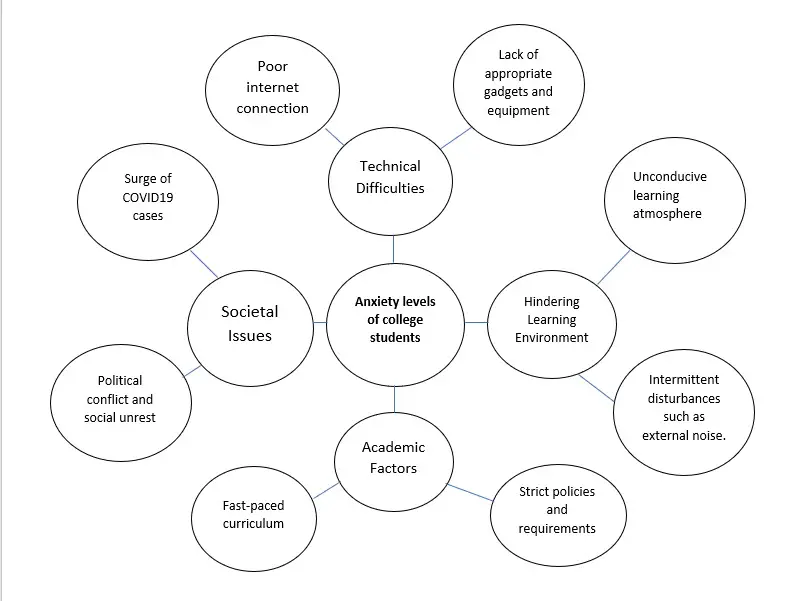
5. Explain Your Conceptual Framework in Narrative Form
Provide a brief explanation of your conceptual framework. State the essential variables, their relationship, and the research outcome.
Using the same example about the relationship between organic fertilizer and the growth rate of the plant, we can come up with the following explanation to accompany the conceptual framework:
Figure 1 shows the Conceptual Framework of the study. The quantity of the organic fertilizer used is the independent variable, while the plant’s growth is the research’s dependent variable. These two variables are directly related based on the research’s empirical evidence.
Conceptual Framework in Quantitative Research
You can create your conceptual framework by following the steps discussed in the previous section. Note, however, that quantitative research has statistical analysis. Thus, you may use arrows to indicate a cause-and-effect relationship in your model. An arrow implies that your independent variable caused the changes in your dependent variable.
Usually, for quantitative research, the Input-Process-Output model is used as a visual diagram. Here is an example of a conceptual framework in quantitative research:
Research Topic : Level of Effectiveness of Corn (Zea mays) Silk Ethanol Extract as an Antioxidant

Conceptual Framework in Qualitative Research
Again, you can follow the same step-by-step guide discussed previously to create a conceptual framework for qualitative research. However, note that you should avoid using one-way arrows as they may indicate causation . Qualitative research cannot prove causation since it uses only descriptive and narrative analysis to relate variables.
Here is an example of a conceptual framework in qualitative research:
Research Topic : Lived Experiences of Medical Health Workers During Community Quarantine
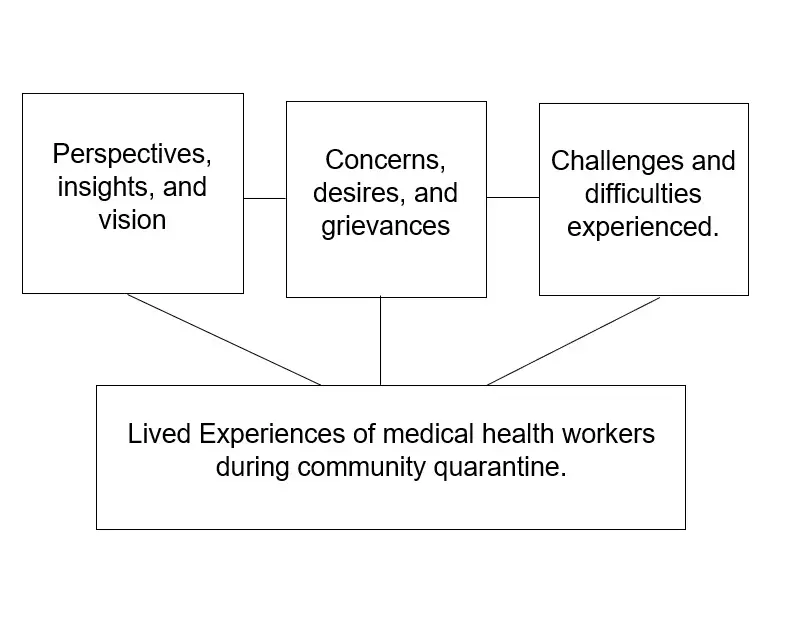
Conceptual Framework Examples
Presented below are some examples of conceptual frameworks.
Research Topic : Hypoglycemic Ability of Gabi (Colocasia esculenta) Leaf Extract in the Blood Glucose Level of Swiss Mice (Mus musculus)

Figure 1 presents the Conceptual Framework of the study. The quantity of gabi leaf extract is the independent variable, while the Swiss mice’s blood glucose level is the study’s dependent variable. This study establishes a direct relationship between these variables through empirical evidence and statistical analysis .
Research Topic : Level of Effectiveness of Using Social Media in the Political Literacy of College Students

Figure 1 shows the Conceptual Framework of the study. The input is the profile of the college students according to sex, year level, and the social media platform being used. The research process includes administering the questionnaires, tabulating students’ responses, and statistical data analysis and interpretation. The output is the effectiveness of using social media in the political literacy of college students.
Research Topic: Factors Affecting the Satisfaction Level of Community Inhabitants
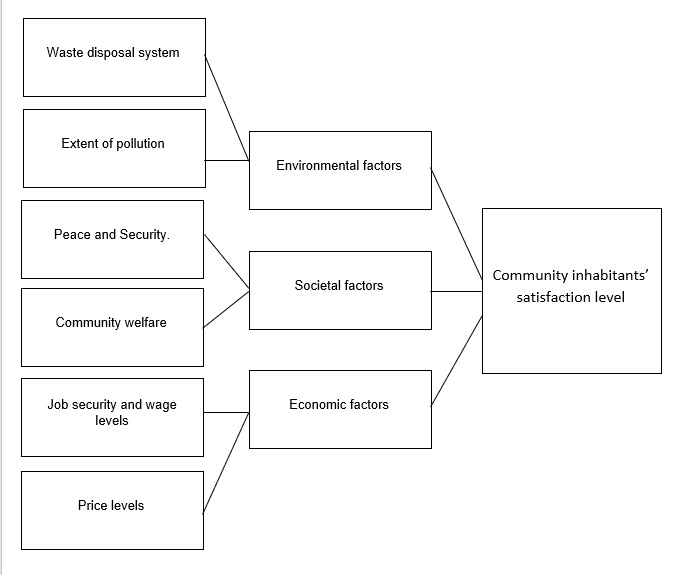
Figure 1 presents a visual illustration of the factors that affect the satisfaction level of community inhabitants. As presented, environmental, societal, and economic factors influence the satisfaction level of community inhabitants. Each factor has its indicators which are considered in this study.
Tips and Warnings
- Please keep it simple. Avoid using fancy illustrations or designs when creating your conceptual framework.
- Allot a lot of space for feedback. This is to show that your research variables or methodology might be revised based on the input from the research panel. Below is an example of a conceptual framework with a spot allotted for feedback.

Frequently Asked Questions
1. how can i create a conceptual framework in microsoft word.
First, click the Insert tab and select Shapes . You’ll see a wide range of shapes to choose from. Usually, rectangles, circles, and arrows are the shapes used for the conceptual framework.

Next, draw your selected shape in the document.
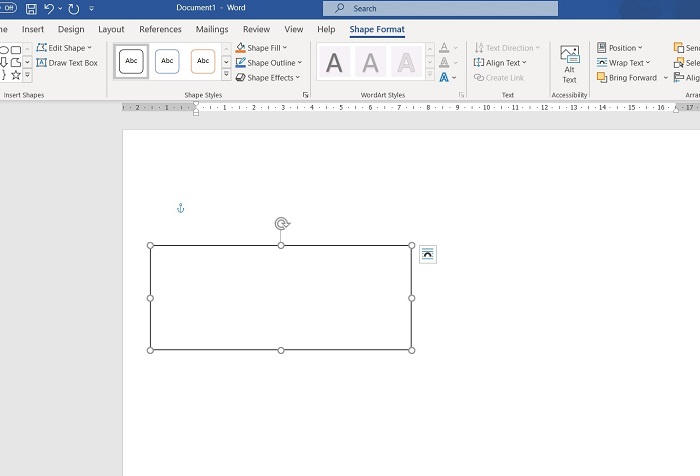
Insert the name of the variable inside the shape. You can do this by pointing your cursor to the shape, right-clicking your mouse, selecting Add Text , and typing in the text.
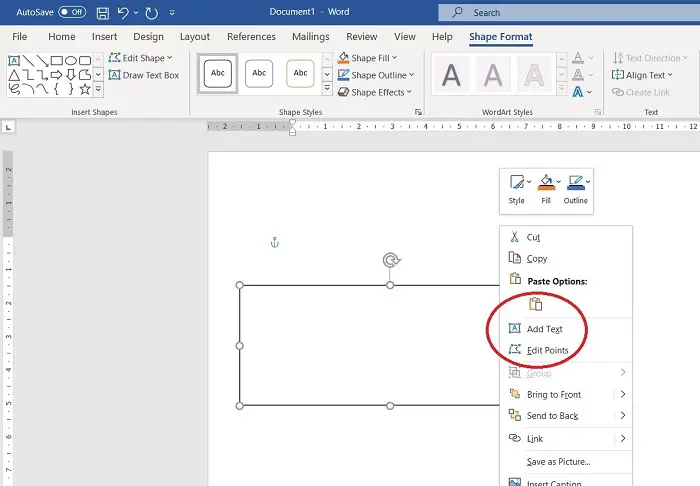
Repeat the same process for the remaining variables of your study. If you need arrows to connect the different variables, you can insert one by going to the Insert tab, then Shape, and finally, Lines or Block Arrows, depending on your preferred arrow style.
2. How to explain my conceptual framework in defense?
If you have used the Independent-Dependent Variable Model in creating your conceptual framework, start by telling your research’s variables. Afterward, explain the relationship between these variables. Example: “Using statistical/descriptive analysis of the data we have collected, we are going to show how the <state your independent variable> exhibits a significant relationship to <state your dependent variable>.”
On the other hand, if you have used an Input-Process-Output Model, start by explaining the inputs of your research. Then, tell them about your research process. You may refer to the Research Methodology in Chapter 3 to accurately present your research process. Lastly, explain what your research outcome is.
Meanwhile, if you have used a concept map, ensure you understand the idea behind the illustration. Discuss how the concepts are related and highlight the research outcome.
3. In what stage of research is the conceptual framework written?
The research study’s conceptual framework is in Chapter 2, following the Review of Related Literature.
4. What is the difference between a Conceptual Framework and Literature Review?
The Conceptual Framework is a summary of the concepts of your study where the relationship of the variables is presented. On the other hand, Literature Review is a collection of published studies and literature related to your study.
Suppose your research concerns the Hypoglycemic Ability of Gabi (Colocasia esculenta) Leaf Extract on Swiss Mice (Mus musculus). In your conceptual framework, you will create a visual diagram and a narrative explanation presenting the quantity of gabi leaf extract and the mice’s blood glucose level as your research variables. On the other hand, for the literature review, you may include this study and explain how this is related to your research topic.
5. When do I use a two-way arrow for my conceptual framework?
You will use a two-way arrow in your conceptual framework if the variables of your study are interdependent. If variable A affects variable B and variable B also affects variable A, you may use a two-way arrow to show that A and B affect each other.
Suppose your research concerns the Relationship Between Students’ Satisfaction Levels and Online Learning Platforms. Since students’ satisfaction level determines the online learning platform the school uses and vice versa, these variables have a direct relationship. Thus, you may use two-way arrows to indicate that the variables directly affect each other.
- Conceptual Framework – Meaning, Importance and How to Write it. (2020). Retrieved 27 April 2021, from https://afribary.com/knowledge/conceptual-framework/
- Correlation vs Causation. Retrieved 27 April 2021, from https://www.jmp.com/en_ph/statistics-knowledge-portal/what-is-correlation/correlation-vs-causation.html
- Swaen, B., & George, T. (2022, August 22). What is a conceptual framework? Tips & Examples. Retrieved December 5, 2022, from https://www.scribbr.com/methodology/conceptual-framework/
Written by Jewel Kyle Fabula
in Career and Education , Juander How
Last Updated May 6, 2023 10:37 AM
Jewel Kyle Fabula
Jewel Kyle Fabula is a Bachelor of Science in Economics student at the University of the Philippines Diliman. His passion for learning mathematics developed as he competed in some mathematics competitions during his Junior High School years. He loves cats, playing video games, and listening to music.
Browse all articles written by Jewel Kyle Fabula
Copyright Notice
All materials contained on this site are protected by the Republic of the Philippines copyright law and may not be reproduced, distributed, transmitted, displayed, published, or broadcast without the prior written permission of filipiknow.net or in the case of third party materials, the owner of that content. You may not alter or remove any trademark, copyright, or other notice from copies of the content. Be warned that we have already reported and helped terminate several websites and YouTube channels for blatantly stealing our content. If you wish to use filipiknow.net content for commercial purposes, such as for content syndication, etc., please contact us at legal(at)filipiknow(dot)net
Have a language expert improve your writing
Run a free plagiarism check in 10 minutes, generate accurate citations for free.
- Knowledge Base
- Methodology
- What Is a Conceptual Framework? | Tips & Examples
What Is a Conceptual Framework? | Tips & Examples
Published on August 2, 2022 by Bas Swaen and Tegan George. Revised on March 18, 2024.

A conceptual framework illustrates the expected relationship between your variables. It defines the relevant objectives for your research process and maps out how they come together to draw coherent conclusions.
Keep reading for a step-by-step guide to help you construct your own conceptual framework.
Table of contents
Developing a conceptual framework in research, step 1: choose your research question, step 2: select your independent and dependent variables, step 3: visualize your cause-and-effect relationship, step 4: identify other influencing variables, frequently asked questions about conceptual models.
A conceptual framework is a representation of the relationship you expect to see between your variables, or the characteristics or properties that you want to study.
Conceptual frameworks can be written or visual and are generally developed based on a literature review of existing studies about your topic.
Your research question guides your work by determining exactly what you want to find out, giving your research process a clear focus.
However, before you start collecting your data, consider constructing a conceptual framework. This will help you map out which variables you will measure and how you expect them to relate to one another.
In order to move forward with your research question and test a cause-and-effect relationship, you must first identify at least two key variables: your independent and dependent variables .
- The expected cause, “hours of study,” is the independent variable (the predictor, or explanatory variable)
- The expected effect, “exam score,” is the dependent variable (the response, or outcome variable).
Note that causal relationships often involve several independent variables that affect the dependent variable. For the purpose of this example, we’ll work with just one independent variable (“hours of study”).
Now that you’ve figured out your research question and variables, the first step in designing your conceptual framework is visualizing your expected cause-and-effect relationship.
We demonstrate this using basic design components of boxes and arrows. Here, each variable appears in a box. To indicate a causal relationship, each arrow should start from the independent variable (the cause) and point to the dependent variable (the effect).

It’s crucial to identify other variables that can influence the relationship between your independent and dependent variables early in your research process.
Some common variables to include are moderating, mediating, and control variables.
Moderating variables
Moderating variable (or moderators) alter the effect that an independent variable has on a dependent variable. In other words, moderators change the “effect” component of the cause-and-effect relationship.
Let’s add the moderator “IQ.” Here, a student’s IQ level can change the effect that the variable “hours of study” has on the exam score. The higher the IQ, the fewer hours of study are needed to do well on the exam.

Let’s take a look at how this might work. The graph below shows how the number of hours spent studying affects exam score. As expected, the more hours you study, the better your results. Here, a student who studies for 20 hours will get a perfect score.

But the graph looks different when we add our “IQ” moderator of 120. A student with this IQ will achieve a perfect score after just 15 hours of study.

Below, the value of the “IQ” moderator has been increased to 150. A student with this IQ will only need to invest five hours of study in order to get a perfect score.

Here, we see that a moderating variable does indeed change the cause-and-effect relationship between two variables.
Mediating variables
Now we’ll expand the framework by adding a mediating variable . Mediating variables link the independent and dependent variables, allowing the relationship between them to be better explained.
Here’s how the conceptual framework might look if a mediator variable were involved:

In this case, the mediator helps explain why studying more hours leads to a higher exam score. The more hours a student studies, the more practice problems they will complete; the more practice problems completed, the higher the student’s exam score will be.
Moderator vs. mediator
It’s important not to confuse moderating and mediating variables. To remember the difference, you can think of them in relation to the independent variable:
- A moderating variable is not affected by the independent variable, even though it affects the dependent variable. For example, no matter how many hours you study (the independent variable), your IQ will not get higher.
- A mediating variable is affected by the independent variable. In turn, it also affects the dependent variable. Therefore, it links the two variables and helps explain the relationship between them.
Control variables
Lastly, control variables must also be taken into account. These are variables that are held constant so that they don’t interfere with the results. Even though you aren’t interested in measuring them for your study, it’s crucial to be aware of as many of them as you can be.

A mediator variable explains the process through which two variables are related, while a moderator variable affects the strength and direction of that relationship.
A confounding variable is closely related to both the independent and dependent variables in a study. An independent variable represents the supposed cause , while the dependent variable is the supposed effect . A confounding variable is a third variable that influences both the independent and dependent variables.
Failing to account for confounding variables can cause you to wrongly estimate the relationship between your independent and dependent variables.
Yes, but including more than one of either type requires multiple research questions .
For example, if you are interested in the effect of a diet on health, you can use multiple measures of health: blood sugar, blood pressure, weight, pulse, and many more. Each of these is its own dependent variable with its own research question.
You could also choose to look at the effect of exercise levels as well as diet, or even the additional effect of the two combined. Each of these is a separate independent variable .
To ensure the internal validity of an experiment , you should only change one independent variable at a time.
A control variable is any variable that’s held constant in a research study. It’s not a variable of interest in the study, but it’s controlled because it could influence the outcomes.
A confounding variable , also called a confounder or confounding factor, is a third variable in a study examining a potential cause-and-effect relationship.
A confounding variable is related to both the supposed cause and the supposed effect of the study. It can be difficult to separate the true effect of the independent variable from the effect of the confounding variable.
In your research design , it’s important to identify potential confounding variables and plan how you will reduce their impact.
Cite this Scribbr article
If you want to cite this source, you can copy and paste the citation or click the “Cite this Scribbr article” button to automatically add the citation to our free Citation Generator.
Swaen, B. & George, T. (2024, March 18). What Is a Conceptual Framework? | Tips & Examples. Scribbr. Retrieved April 11, 2024, from https://www.scribbr.com/methodology/conceptual-framework/
Is this article helpful?
Other students also liked
Independent vs. dependent variables | definition & examples, mediator vs. moderator variables | differences & examples, control variables | what are they & why do they matter, unlimited academic ai-proofreading.
✔ Document error-free in 5minutes ✔ Unlimited document corrections ✔ Specialized in correcting academic texts
- Privacy Policy
Buy Me a Coffee

Home » Conceptual Framework – Types, Methodology and Examples
Conceptual Framework – Types, Methodology and Examples
Table of Contents

Conceptual Framework
Definition:
A conceptual framework is a structured approach to organizing and understanding complex ideas, theories, or concepts. It provides a systematic and coherent way of thinking about a problem or topic, and helps to guide research or analysis in a particular field.
A conceptual framework typically includes a set of assumptions, concepts, and propositions that form a theoretical framework for understanding a particular phenomenon. It can be used to develop hypotheses, guide empirical research, or provide a framework for evaluating and interpreting data.
Conceptual Framework in Research
In research, a conceptual framework is a theoretical structure that provides a framework for understanding a particular phenomenon or problem. It is a key component of any research project and helps to guide the research process from start to finish.
A conceptual framework provides a clear understanding of the variables, relationships, and assumptions that underpin a research study. It outlines the key concepts that the study is investigating and how they are related to each other. It also defines the scope of the study and sets out the research questions or hypotheses.
Types of Conceptual Framework
Types of Conceptual Framework are as follows:
Theoretical Framework
A theoretical framework is an overarching set of concepts, ideas, and assumptions that help to explain and interpret a phenomenon. It provides a theoretical perspective on the phenomenon being studied and helps researchers to identify the relationships between different concepts. For example, a theoretical framework for a study on the impact of social media on mental health might draw on theories of communication, social influence, and psychological well-being.
Conceptual Model
A conceptual model is a visual or written representation of a complex system or phenomenon. It helps to identify the main components of the system and the relationships between them. For example, a conceptual model for a study on the factors that influence employee turnover might include factors such as job satisfaction, salary, work-life balance, and job security, and the relationships between them.
Empirical Framework
An empirical framework is based on empirical data and helps to explain a particular phenomenon. It involves collecting data, analyzing it, and developing a framework to explain the results. For example, an empirical framework for a study on the impact of a new health intervention might involve collecting data on the intervention’s effectiveness, cost, and acceptability to patients.
Descriptive Framework
A descriptive framework is used to describe a particular phenomenon. It helps to identify the main characteristics of the phenomenon and to develop a vocabulary to describe it. For example, a descriptive framework for a study on different types of musical genres might include descriptions of the instruments used, the rhythms and beats, the vocal styles, and the cultural contexts of each genre.
Analytical Framework
An analytical framework is used to analyze a particular phenomenon. It involves breaking down the phenomenon into its constituent parts and analyzing them separately. This type of framework is often used in social science research. For example, an analytical framework for a study on the impact of race on police brutality might involve analyzing the historical and cultural factors that contribute to racial bias, the organizational factors that influence police behavior, and the psychological factors that influence individual officers’ behavior.
Conceptual Framework for Policy Analysis
A conceptual framework for policy analysis is used to guide the development of policies or programs. It helps policymakers to identify the key issues and to develop strategies to address them. For example, a conceptual framework for a policy analysis on climate change might involve identifying the key stakeholders, assessing their interests and concerns, and developing policy options to mitigate the impacts of climate change.
Logical Frameworks
Logical frameworks are used to plan and evaluate projects and programs. They provide a structured approach to identifying project goals, objectives, and outcomes, and help to ensure that all stakeholders are aligned and working towards the same objectives.
Conceptual Frameworks for Program Evaluation
These frameworks are used to evaluate the effectiveness of programs or interventions. They provide a structure for identifying program goals, objectives, and outcomes, and help to measure the impact of the program on its intended beneficiaries.
Conceptual Frameworks for Organizational Analysis
These frameworks are used to analyze and evaluate organizational structures, processes, and performance. They provide a structured approach to understanding the relationships between different departments, functions, and stakeholders within an organization.
Conceptual Frameworks for Strategic Planning
These frameworks are used to develop and implement strategic plans for organizations or businesses. They help to identify the key factors and stakeholders that will impact the success of the plan, and provide a structure for setting goals, developing strategies, and monitoring progress.
Components of Conceptual Framework
The components of a conceptual framework typically include:
- Research question or problem statement : This component defines the problem or question that the conceptual framework seeks to address. It sets the stage for the development of the framework and guides the selection of the relevant concepts and constructs.
- Concepts : These are the general ideas, principles, or categories that are used to describe and explain the phenomenon or problem under investigation. Concepts provide the building blocks of the framework and help to establish a common language for discussing the issue.
- Constructs : Constructs are the specific variables or concepts that are used to operationalize the general concepts. They are measurable or observable and serve as indicators of the underlying concept.
- Propositions or hypotheses : These are statements that describe the relationships between the concepts or constructs in the framework. They provide a basis for testing the validity of the framework and for generating new insights or theories.
- Assumptions : These are the underlying beliefs or values that shape the framework. They may be explicit or implicit and may influence the selection and interpretation of the concepts and constructs.
- Boundaries : These are the limits or scope of the framework. They define the focus of the investigation and help to clarify what is included and excluded from the analysis.
- Context : This component refers to the broader social, cultural, and historical factors that shape the phenomenon or problem under investigation. It helps to situate the framework within a larger theoretical or empirical context and to identify the relevant variables and factors that may affect the phenomenon.
- Relationships and connections: These are the connections and interrelationships between the different components of the conceptual framework. They describe how the concepts and constructs are linked and how they contribute to the overall understanding of the phenomenon or problem.
- Variables : These are the factors that are being measured or observed in the study. They are often operationalized as constructs and are used to test the propositions or hypotheses.
- Methodology : This component describes the research methods and techniques that will be used to collect and analyze data. It includes the sampling strategy, data collection methods, data analysis techniques, and ethical considerations.
- Literature review : This component provides an overview of the existing research and theories related to the phenomenon or problem under investigation. It helps to identify the gaps in the literature and to situate the framework within the broader theoretical and empirical context.
- Outcomes and implications: These are the expected outcomes or implications of the study. They describe the potential contributions of the study to the theoretical and empirical knowledge in the field and the practical implications for policy and practice.
Conceptual Framework Methodology
Conceptual Framework Methodology is a research method that is commonly used in academic and scientific research to develop a theoretical framework for a study. It is a systematic approach that helps researchers to organize their thoughts and ideas, identify the variables that are relevant to their study, and establish the relationships between these variables.
Here are the steps involved in the conceptual framework methodology:
Identify the Research Problem
The first step is to identify the research problem or question that the study aims to answer. This involves identifying the gaps in the existing literature and determining what specific issue the study aims to address.
Conduct a Literature Review
The second step involves conducting a thorough literature review to identify the existing theories, models, and frameworks that are relevant to the research question. This will help the researcher to identify the key concepts and variables that need to be considered in the study.
Define key Concepts and Variables
The next step is to define the key concepts and variables that are relevant to the study. This involves clearly defining the terms used in the study, and identifying the factors that will be measured or observed in the study.
Develop a Theoretical Framework
Once the key concepts and variables have been identified, the researcher can develop a theoretical framework. This involves establishing the relationships between the key concepts and variables, and creating a visual representation of these relationships.
Test the Framework
The final step is to test the theoretical framework using empirical data. This involves collecting and analyzing data to determine whether the relationships between the key concepts and variables that were identified in the framework are accurate and valid.
Examples of Conceptual Framework
Some realtime Examples of Conceptual Framework are as follows:
- In economics , the concept of supply and demand is a well-known conceptual framework. It provides a structure for understanding how prices are set in a market, based on the interplay of the quantity of goods supplied by producers and the quantity of goods demanded by consumers.
- In psychology , the cognitive-behavioral framework is a widely used conceptual framework for understanding mental health and illness. It emphasizes the role of thoughts and behaviors in shaping emotions and the importance of cognitive restructuring and behavior change in treatment.
- In sociology , the social determinants of health framework provides a way of understanding how social and economic factors such as income, education, and race influence health outcomes. This framework is widely used in public health research and policy.
- In environmental science , the ecosystem services framework is a way of understanding the benefits that humans derive from natural ecosystems, such as clean air and water, pollination, and carbon storage. This framework is used to guide conservation and land-use decisions.
- In education, the constructivist framework is a way of understanding how learners construct knowledge through active engagement with their environment. This framework is used to guide instructional design and teaching strategies.
Applications of Conceptual Framework
Some of the applications of Conceptual Frameworks are as follows:
- Research : Conceptual frameworks are used in research to guide the design, implementation, and interpretation of studies. Researchers use conceptual frameworks to develop hypotheses, identify research questions, and select appropriate methods for collecting and analyzing data.
- Policy: Conceptual frameworks are used in policy-making to guide the development of policies and programs. Policymakers use conceptual frameworks to identify key factors that influence a particular problem or issue, and to develop strategies for addressing them.
- Education : Conceptual frameworks are used in education to guide the design and implementation of instructional strategies and curriculum. Educators use conceptual frameworks to identify learning objectives, select appropriate teaching methods, and assess student learning.
- Management : Conceptual frameworks are used in management to guide decision-making and strategy development. Managers use conceptual frameworks to understand the internal and external factors that influence their organizations, and to develop strategies for achieving their goals.
- Evaluation : Conceptual frameworks are used in evaluation to guide the development of evaluation plans and to interpret evaluation results. Evaluators use conceptual frameworks to identify key outcomes, indicators, and measures, and to develop a logic model for their evaluation.
Purpose of Conceptual Framework
The purpose of a conceptual framework is to provide a theoretical foundation for understanding and analyzing complex phenomena. Conceptual frameworks help to:
- Guide research : Conceptual frameworks provide a framework for researchers to develop hypotheses, identify research questions, and select appropriate methods for collecting and analyzing data. By providing a theoretical foundation for research, conceptual frameworks help to ensure that research is rigorous, systematic, and valid.
- Provide clarity: Conceptual frameworks help to provide clarity and structure to complex phenomena by identifying key concepts, relationships, and processes. By providing a clear and systematic understanding of a phenomenon, conceptual frameworks help to ensure that researchers, policymakers, and practitioners are all on the same page when it comes to understanding the issue at hand.
- Inform decision-making : Conceptual frameworks can be used to inform decision-making and strategy development by identifying key factors that influence a particular problem or issue. By understanding the complex interplay of factors that contribute to a particular issue, decision-makers can develop more effective strategies for addressing the problem.
- Facilitate communication : Conceptual frameworks provide a common language and conceptual framework for researchers, policymakers, and practitioners to communicate and collaborate on complex issues. By providing a shared understanding of a phenomenon, conceptual frameworks help to ensure that everyone is working towards the same goal.
When to use Conceptual Framework
There are several situations when it is appropriate to use a conceptual framework:
- To guide the research : A conceptual framework can be used to guide the research process by providing a clear roadmap for the research project. It can help researchers identify key variables and relationships, and develop hypotheses or research questions.
- To clarify concepts : A conceptual framework can be used to clarify and define key concepts and terms used in a research project. It can help ensure that all researchers are using the same language and have a shared understanding of the concepts being studied.
- To provide a theoretical basis: A conceptual framework can provide a theoretical basis for a research project by linking it to existing theories or conceptual models. This can help researchers build on previous research and contribute to the development of a field.
- To identify gaps in knowledge : A conceptual framework can help identify gaps in existing knowledge by highlighting areas that require further research or investigation.
- To communicate findings : A conceptual framework can be used to communicate research findings by providing a clear and concise summary of the key variables, relationships, and assumptions that underpin the research project.
Characteristics of Conceptual Framework
key characteristics of a conceptual framework are:
- Clear definition of key concepts : A conceptual framework should clearly define the key concepts and terms being used in a research project. This ensures that all researchers have a shared understanding of the concepts being studied.
- Identification of key variables: A conceptual framework should identify the key variables that are being studied and how they are related to each other. This helps to organize the research project and provides a clear focus for the study.
- Logical structure: A conceptual framework should have a logical structure that connects the key concepts and variables being studied. This helps to ensure that the research project is coherent and consistent.
- Based on existing theory : A conceptual framework should be based on existing theory or conceptual models. This helps to ensure that the research project is grounded in existing knowledge and builds on previous research.
- Testable hypotheses or research questions: A conceptual framework should include testable hypotheses or research questions that can be answered through empirical research. This helps to ensure that the research project is rigorous and scientifically valid.
- Flexibility : A conceptual framework should be flexible enough to allow for modifications as new information is gathered during the research process. This helps to ensure that the research project is responsive to new findings and is able to adapt to changing circumstances.
Advantages of Conceptual Framework
Advantages of the Conceptual Framework are as follows:
- Clarity : A conceptual framework provides clarity to researchers by outlining the key concepts and variables that are relevant to the research project. This clarity helps researchers to focus on the most important aspects of the research problem and develop a clear plan for investigating it.
- Direction : A conceptual framework provides direction to researchers by helping them to develop hypotheses or research questions that are grounded in existing theory or conceptual models. This direction ensures that the research project is relevant and contributes to the development of the field.
- Efficiency : A conceptual framework can increase efficiency in the research process by providing a structure for organizing ideas and data. This structure can help researchers to avoid redundancies and inconsistencies in their work, saving time and effort.
- Rigor : A conceptual framework can help to ensure the rigor of a research project by providing a theoretical basis for the investigation. This rigor is essential for ensuring that the research project is scientifically valid and produces meaningful results.
- Communication : A conceptual framework can facilitate communication between researchers by providing a shared language and understanding of the key concepts and variables being studied. This communication is essential for collaboration and the advancement of knowledge in the field.
- Generalization : A conceptual framework can help to generalize research findings beyond the specific study by providing a theoretical basis for the investigation. This generalization is essential for the development of knowledge in the field and for informing future research.
Limitations of Conceptual Framework
Limitations of Conceptual Framework are as follows:
- Limited applicability: Conceptual frameworks are often based on existing theory or conceptual models, which may not be applicable to all research problems or contexts. This can limit the usefulness of a conceptual framework in certain situations.
- Lack of empirical support : While a conceptual framework can provide a theoretical basis for a research project, it may not be supported by empirical evidence. This can limit the usefulness of a conceptual framework in guiding empirical research.
- Narrow focus: A conceptual framework can provide a clear focus for a research project, but it may also limit the scope of the investigation. This can make it difficult to address broader research questions or to consider alternative perspectives.
- Over-simplification: A conceptual framework can help to organize and structure research ideas, but it may also over-simplify complex phenomena. This can limit the depth of the investigation and the richness of the data collected.
- Inflexibility : A conceptual framework can provide a structure for organizing research ideas, but it may also be inflexible in the face of new data or unexpected findings. This can limit the ability of researchers to adapt their research project to new information or changing circumstances.
- Difficulty in development : Developing a conceptual framework can be a challenging and time-consuming process. It requires a thorough understanding of existing theory or conceptual models, and may require collaboration with other researchers.
About the author
Muhammad Hassan
Researcher, Academic Writer, Web developer
You may also like

Data Collection – Methods Types and Examples

Delimitations in Research – Types, Examples and...

Research Process – Steps, Examples and Tips

Research Design – Types, Methods and Examples

Institutional Review Board – Application Sample...

Evaluating Research – Process, Examples and...
Educational resources and simple solutions for your research journey

What is a Conceptual Framework and How to Make It (with Examples)

A strong conceptual framework underpins good research. A conceptual framework in research is used to understand a research problem and guide the development and analysis of the research. It serves as a roadmap to conceptualize and structure the work by providing an outline that connects different ideas, concepts, and theories within the field of study. A conceptual framework pictorially or verbally depicts presumed relationships among the study variables.
The purpose of a conceptual framework is to serve as a scheme for organizing and categorizing knowledge and thereby help researchers in developing theories and hypotheses and conducting empirical studies.
In this post, we explain what is a conceptual framework, and provide expert advice on how to make a conceptual framework, along with conceptual framework examples.
Table of Contents
What is a Conceptual Framework in Research
Definition of a conceptual framework.
A conceptual framework includes key concepts, variables, relationships, and assumptions that guide the academic inquiry. It establishes the theoretical underpinnings and provides a lens through which researchers can analyze and interpret data. A conceptual framework draws upon existing theories, models, or established bodies of knowledge to provide a structure for understanding the research problem. It defines the scope of research, identifying relevant variables, establishing research questions, and guiding the selection of appropriate methodologies and data analysis techniques.
Conceptual frameworks can be written or visual. Other types of conceptual framework representations might be taxonomic (verbal description categorizing phenomena into classes without showing relationships between classes) or mathematical descriptions (expression of phenomena in the form of mathematical equations).
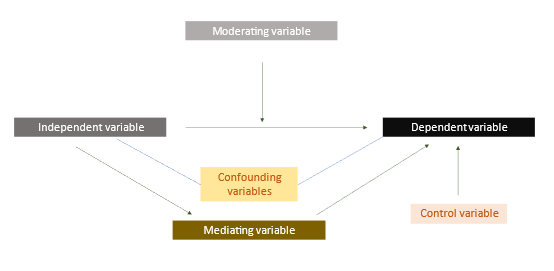
Figure 1: Definition of a conceptual framework explained diagrammatically
Conceptual Framework Origin
The term conceptual framework appears to have originated in philosophy and systems theory, being used for the first time in the 1930s by the philosopher Alfred North Whitehead. He bridged the theological, social, and physical sciences by providing a common conceptual framework. The use of the conceptual framework began early in accountancy and can be traced back to publications by William A. Paton and John B. Canning in the first quarter of the 20 th century. Thus, in the original framework, financial issues were addressed, such as useful features, basic elements, and variables needed to prepare financial statements. Nevertheless, a conceptual framework approach should be considered when starting your research journey in any field, from finance to social sciences to applied sciences.
Purpose and Importance of a Conceptual Framework in Research
The importance of a conceptual framework in research cannot be understated, irrespective of the field of study. It is important for the following reasons:
- It clarifies the context of the study.
- It justifies the study to the reader.
- It helps you check your own understanding of the problem and the need for the study.
- It illustrates the expected relationship between the variables and defines the objectives for the research.
- It helps further refine the study objectives and choose the methods appropriate to meet them.
What to Include in a Conceptual Framework
Essential elements that a conceptual framework should include are as follows:
- Overarching research question(s)
- Study parameters
- Study variables
- Potential relationships between those variables.
The sources for these elements of a conceptual framework are literature, theory, and experience or prior knowledge.
How to Make a Conceptual Framework
Now that you know the essential elements, your next question will be how to make a conceptual framework.
For this, start by identifying the most suitable set of questions that your research aims to answer. Next, categorize the various variables. Finally, perform a rigorous analysis of the collected data and compile the final results to establish connections between the variables.
In short, the steps are as follows:
- Choose appropriate research questions.
- Define the different types of variables involved.
- Determine the cause-and-effect relationships.
Be sure to make use of arrows and lines to depict the presence or absence of correlational linkages among the variables.
Developing a Conceptual Framework
Researchers should be adept at developing a conceptual framework. Here are the steps for developing a conceptual framework:
1. Identify a research question
Your research question guides your entire study, making it imperative to invest time and effort in formulating a question that aligns with your research goals and contributes to the existing body of knowledge. This step involves the following:
- Choose a broad topic of interest
- Conduct background research
- Narrow down the focus
- Define your goals
- Make it specific and answerable
- Consider significance and novelty
- Seek feedback.
2. Choose independent and dependent variables
The dependent variable is the main outcome you want to measure, explain, or predict in your study. It should be a variable that can be observed, measured, or assessed quantitatively or qualitatively. Independent variables are the factors or variables that may influence, explain, or predict changes in the dependent variable.
Choose independent and dependent variables for your study according to the research objectives, the nature of the phenomenon being studied, and the specific research design. The identification of variables is rooted in existing literature, theories, or your own observations.
3. Consider cause-and-effect relationships
To better understand and communicate the relationships between variables in your study, cause-and-effect relationships need to be visualized. This can be done by using path diagrams, cause-and-effect matrices, time series plots, scatter plots, bar charts, or heatmaps.
4. Identify other influencing variables
Besides the independent and dependent variables, researchers must understand and consider the following types of variables:
- Moderating variable: A variable that influences the strength or direction of the relationship between an independent variable and a dependent variable.
- Mediating variable: A variable that explains the relationship between an independent variable and a dependent variable and clarifies how the independent variable affects the dependent variable.
- Control variable: A variable that is kept constant or controlled to avoid the influence of other factors that may affect the relationship between the independent and dependent variables.
- Confounding variable: A type of unmeasured variable that is related to both the independent and dependent variables.
Example of a Conceptual Framework
Let us examine the following conceptual framework example. Let’s say your research topic is “ The Impact of Social Media Usage on Academic Performance among College Students .” Here, you want to investigate how social media usage affects academic performance in college students. Social media usage (encompassing frequency of social media use, time spent on social media platforms, and types of social media platforms used) is the independent variable, and academic performance (covering grades, exam scores, and class attendance) is the dependent variable.
This conceptual framework example also includes a mediating variable, study habits, which may explain how social media usage affects academic performance. Study habits (time spent studying, study environment, and use of study aids or resources) can act as a mechanism through which social media usage influences academic outcomes. Additionally, a moderating variable, self-discipline (level of self-control and self-regulation, ability to manage distractions, and prioritization skills), is included to examine how individual differences in self-control and discipline may influence the relationship between social media usage and academic performance.
Confounding variables are also identified (socioeconomic status, prior academic achievement), which are potential factors that may influence both social media usage and academic performance. These variables need to be considered and controlled in the study to ensure that any observed effects are specifically attributed to social media usage. A visual representation of this conceptual framework example is seen in Figure 2.

Figure 2: Visual representation of a conceptual framework for the topic “The Impact of Social Media Usage on Academic Performance among College Students”
Key Takeaways
Here is a snapshot of the basics of a conceptual framework in research:
- A conceptual framework is an idea or model representing the subject or phenomena you intend to study.
- It is primarily a researcher’s perception of the research problem. It can be used to develop hypotheses or testable research questions.
- It provides a preliminary understanding of the factors at play, their interrelationships, and the underlying reasons.
- It guides your research by aiding in the formulation of meaningful research questions, selection of appropriate methods, and identification of potential challenges to the validity of your findings.
- It provides a structure for organizing and understanding data.
- It allows you to chalk out the relationships between concepts and variables to understand them.
- Variables besides dependent and independent variables (moderating, mediating, control, and confounding variables) must be considered when developing a conceptual framework.
Frequently Asked Questions
What is the difference between a moderating variable and a mediating variable.
Moderating and mediating variables are easily confused. A moderating variable affects the direction and strength of this relationship, whereas a mediating explains how two variables relate.
What is the difference between independent variables, dependent variables, and confounding variables?
Independent variables are the variables manipulated to affect the outcome of an experiment (e.g., the dose of a fat-loss drug administered to rats). Dependent variables are variables being measured or observed in an experiment (e.g., changes in rat body weight as a result of the drug). A confounding variable distorts or masks the effects of the variables being studied because it is associated both with dependent variable and with the independent variable. For instance, in this example, pre-existing metabolic dysfunction in some rats could interact differently with the drug being studied and also affect rat body weight.
Should I have more than one dependent or independent variable in a study?
The need for more than one dependent or independent variable in a study depends on the research question, study design, and relationships being investigated. Note the following when making this decision for your research:
- If your research question involves exploring the relationships between multiple variables or factors, it may be appropriate to have more than one dependent or independent variable.
- If you have specific hypotheses about the relationships between several variables, it may be necessary to include multiple dependent or independent variables.
- Adequate resources, sample size, and data collection methods should be considered when determining the number of dependent and independent variables to include.
What is a confounding variable?
A confounding variable is not the main focus of the study but can unintentionally influence the relationship between the independent and dependent variables. Confounding variables can introduce bias and give rise to misleading conclusions. These variables must be controlled to ensure that any observed relationship is genuinely due to the independent variable.
What is a control variable?
A control variable is something not of interest to the study’s objectives but is kept constant because it could influence the outcomes. Control variables can help prevent research biases and allow for a more accurate assessment of the relationship between the independent and dependent variables. Examples are (i) testing all participants at the same time (e.g., in the morning) to minimize the potential effects of circadian rhythms, (ii) ensuring that instruments are calibrated consistently before each measurement to minimize the influence of measurement errors, and (iii) randomization of participants across study groups.
R Discovery is a literature search and research reading platform that accelerates your research discovery journey by keeping you updated on the latest, most relevant scholarly content. With 250M+ research articles sourced from trusted aggregators like CrossRef, Unpaywall, PubMed, PubMed Central, Open Alex and top publishing houses like Springer Nature, JAMA, IOP, Taylor & Francis, NEJM, BMJ, Karger, SAGE, Emerald Publishing and more, R Discovery puts a world of research at your fingertips.
Try R Discovery Prime FREE for 1 week or upgrade at just US$39 a year to access premium features that let you listen to research on the go, read in your language, collaborate with peers, auto sync with reference managers, and much more. Choose a simpler, smarter way to find and read research – Download the app and start your free 7-day trial today !
Related Posts

Fake Papers and Paper Mill Publishing : An Alarming Trend in Scientific Research

Top AI Tools for Literature Review
What is a good example of a conceptual framework?
Last updated
18 April 2023
Reviewed by
Miroslav Damyanov
A well-designed study doesn’t just happen. Researchers work hard to ensure the studies they conduct will be scientifically valid and will advance understanding in their field.
Make research less tedious
Dovetail streamlines research to help you uncover and share actionable insights
- The importance of a conceptual framework
The main purpose of a conceptual framework is to improve the quality of a research study. A conceptual framework achieves this by identifying important information about the topic and providing a clear roadmap for researchers to study it.
Through the process of developing this information, researchers will be able to improve the quality of their studies in a few key ways.
Clarify research goals and objectives
A conceptual framework helps researchers create a clear research goal. Research projects often become vague and lose their focus, which makes them less useful. However, a well-designed conceptual framework helps researchers maintain focus. It reinforces the project’s scope, ensuring it stays on track and produces meaningful results.
Provide a theoretical basis for the study
Forming a hypothesis requires knowledge of the key variables and their relationship to each other. Researchers need to identify these variables early on to create a conceptual framework. This ensures researchers have developed a strong understanding of the topic before finalizing the study design. It also helps them select the most appropriate research and analysis methods.
Guide the research design
As they develop their conceptual framework, researchers often uncover information that can help them further refine their work.
Here are some examples:
Confounding variables they hadn’t previously considered
Sources of bias they will have to take into account when designing the project
Whether or not the information they were going to study has already been covered—this allows them to pivot to a more meaningful goal that brings new and relevant information to their field
- Steps to develop a conceptual framework
There are four major steps researchers will follow to develop a conceptual framework. Each step will be described in detail in the sections that follow. You’ll also find examples of how each might be applied in a range of fields.
Step 1: Choose the research question
The first step in creating a conceptual framework is choosing a research question . The goal of this step is to create a question that’s specific and focused.
By developing a clear question, researchers can more easily identify the variables they will need to account for and keep their research focused. Without it, the next steps will be more difficult and less effective.
Here are some examples of good research questions in a few common fields:
Natural sciences: How does exposure to ultraviolet radiation affect the growth rate of a particular type of algae?
Health sciences: What is the effectiveness of cognitive-behavioral therapy for treating depression in adolescents?
Business: What factors contribute to the success of small businesses in a particular industry?
Education: How does implementing technology in the classroom impact student learning outcomes?
Step 2: Select the independent and dependent variables
Once the research question has been chosen, it’s time to identify the dependent and independent variables .
The independent variable is the variable researchers think will affect the dependent variable . Without this information, researchers cannot develop a meaningful hypothesis or design a way to test it.
The dependent and independent variables for our example questions above are:

Natural sciences
Independent variable: exposure to ultraviolet radiation
Dependent variable: the growth rate of a particular type of algae
Health sciences
Independent variable: cognitive-behavioral therapy
Dependent variable: depression in adolescents
Independent variables: factors contributing to the business’s success
Dependent variable: sales, return on investment (ROI), or another concrete metric
Independent variable: implementation of technology in the classroom
Dependent variable: student learning outcomes, such as test scores, GPAs, or exam results
Step 3: Visualize the cause-and-effect relationship
This step is where researchers actually develop their hypothesis. They will predict how the independent variable will impact the dependent variable based on their knowledge of the field and their intuition.
With a hypothesis formed, researchers can more accurately determine what data to collect and how to analyze it. They will then visualize their hypothesis by creating a diagram. This visualization will serve as a framework to help guide their research.
The diagrams for our examples might be used as follows:
Natural sciences : how exposure to radiation affects the biological processes in the algae that contribute to its growth rate
Health sciences : how different aspects of cognitive behavioral therapy can affect how patients experience symptoms of depression
Business : how factors such as market demand, managerial expertise, and financial resources influence a business’s success
Education : how different types of technology interact with different aspects of the learning process and alter student learning outcomes
Step 4: Identify other influencing variables
The independent and dependent variables are only part of the equation. Moderating, mediating, and control variables are also important parts of a well-designed study. These variables can impact the relationship between the two main variables and must be accounted for.
A moderating variable is one that can change how the independent variable affects the dependent variable. A mediating variable explains the relationship between the two. Control variables are kept the same to eliminate their impact on the results. Examples of each are given below:
Moderating variable: water temperature (might impact how algae respond to radiation exposure)
Mediating variable: chlorophyll production (might explain how radiation exposure affects algae growth rate)
Control variable: nutrient levels in the water
Moderating variable: the severity of depression symptoms at baseline might impact how effective the therapy is for different adolescents
Mediating variable: social support might explain how cognitive-behavioral therapy leads to improvements in depression
Control variable: other forms of treatment received before or during the study
Moderating variable: the size of the business (might impact how different factors contribute to market share, sales, ROI, and other key success metrics)
Mediating variable: customer satisfaction (might explain how different factors impact business success)
Control variable: industry competition
Moderating variable: student age (might impact how effective technology is for different students)
Mediating variable: teacher training (might explain how technology leads to improvements in learning outcomes)
Control variable: student learning style
- Conceptual versus theoretical frameworks
Although they sound similar, conceptual and theoretical frameworks have different goals and are used in different contexts. Understanding which to use will help researchers craft better studies.
Conceptual frameworks describe a broad overview of the subject and outline key concepts, variables, and the relationships between them. They provide structure to studies that are more exploratory in nature, where the relationships between the variables are still being established. They are particularly helpful in studies that are complex or interdisciplinary because they help researchers better organize the factors involved in the study.
Theoretical frameworks, on the other hand, are used when the research question is more clearly defined and there’s an existing body of work to draw upon. They define the relationships between the variables and help researchers predict outcomes. They are particularly helpful when researchers want to refine the existing body of knowledge rather than establish it.
Get started today
Go from raw data to valuable insights with a flexible research platform
Editor’s picks
Last updated: 21 December 2023
Last updated: 16 December 2023
Last updated: 6 October 2023
Last updated: 5 March 2024
Last updated: 25 November 2023
Last updated: 15 February 2024
Last updated: 11 March 2024
Last updated: 12 December 2023
Last updated: 6 March 2024
Last updated: 10 April 2023
Last updated: 20 December 2023
Latest articles
Related topics, log in or sign up.
Get started for free
- Link to facebook
- Link to linkedin
- Link to twitter
- Link to youtube
- Writing Tips
How to Make a Conceptual Framework

- 6-minute read
- 2nd January 2022
What is a conceptual framework? And why is it important?
A conceptual framework illustrates the relationship between the variables of a research question. It’s an outline of what you’d expect to find in a research project.
Conceptual frameworks should be constructed before data collection and are vital because they map out the actions needed in the study. This should be the first step of an undergraduate or graduate research project.
What Is In a Conceptual Framework?
In a conceptual framework, you’ll find a visual representation of the key concepts and relationships that are central to a research study or project . This can be in form of a diagram, flow chart, or any other visual representation. Overall, a conceptual framework serves as a guide for understanding the problem being studied and the methods being used to investigate it.
Steps to Developing the Perfect Conceptual Framework
- Pick a question
- Conduct a literature review
- Identify your variables
- Create your conceptual framework
1. Pick a Question
You should already have some idea of the broad area of your research project. Try to narrow down your research field to a manageable topic in terms of time and resources. From there, you need to formulate your research question. A research question answers the researcher’s query: “What do I want to know about my topic?” Research questions should be focused, concise, arguable and, ideally, should address a topic of importance within your field of research.
An example of a simple research question is: “What is the relationship between sunny days and ice cream sales?”
2. Conduct a Literature Review
A literature review is an analysis of the scholarly publications on a chosen topic. To undertake a literature review, search for articles with the same theme as your research question. Choose updated and relevant articles to analyze and use peer-reviewed and well-respected journals whenever possible.
For the above example, the literature review would investigate publications that discuss how ice cream sales are affected by the weather. The literature review should reveal the variables involved and any current hypotheses about this relationship.
3. Identify Your Variables
There are two key variables in every experiment: independent and dependent variables.
Independent Variables
The independent variable (otherwise known as the predictor or explanatory variable) is the expected cause of the experiment: what the scientist changes or changes on its own. In our example, the independent variable would be “the number of sunny days.”
Dependent Variables
The dependent variable (otherwise known as the response or outcome variable) is the expected effect of the experiment: what is being studied or measured. In our example, the dependent variable would be “the quantity of ice cream sold.”
Next, there are control variables.
Control Variables
A control variable is a variable that may impact the dependent variable but whose effects are not going to be measured in the research project. In our example, a control variable could be “the socioeconomic status of participants.” Control variables should be kept constant to isolate the effects of the other variables in the experiment.
Finally, there are intervening and extraneous variables.
Find this useful?
Subscribe to our newsletter and get writing tips from our editors straight to your inbox.
Intervening Variables
Intervening variables link the independent and dependent variables and clarify their connection. In our example, an intervening variable could be “temperature.”
Extraneous Variables
Extraneous variables are any variables that are not being investigated but could impact the outcomes of the study. Some instances of extraneous variables for our example would be “the average price of ice cream” or “the number of varieties of ice cream available.” If you control an extraneous variable, it becomes a control variable.
4. Create Your Conceptual Framework
Having picked your research question, undertaken a literature review, and identified the relevant variables, it’s now time to construct your conceptual framework. Conceptual frameworks are clear and often visual representations of the relationships between variables.
We’ll start with the basics: the independent and dependent variables.
Our hypothesis is that the quantity of ice cream sold directly depends on the number of sunny days; hence, there is a cause-and-effect relationship between the independent variable (the number of sunny days) and the dependent and independent variable (the quantity of ice cream sold).
Next, introduce a control variable. Remember, this is anything that might directly affect the dependent variable but is not being measured in the experiment:
Finally, introduce the intervening and extraneous variables.
The intervening variable (temperature) clarifies the relationship between the independent variable (the number of sunny days) and the dependent variable (the quantity of ice cream sold). Extraneous variables, such as the average price of ice cream, are variables that are not controlled and can potentially impact the dependent variable.
Are Conceptual Frameworks and Research Paradigms the Same?
In simple terms, the research paradigm is what informs your conceptual framework. In defining our research paradigm we ask the big questions—Is there an objective truth and how can we understand it? If we decide the answer is yes, we may be working with a positivist research paradigm and will choose to build a conceptual framework that displays the relationship between fixed variables. If not, we may be working with a constructivist research paradigm, and thus our conceptual framework will be more of a loose amalgamation of ideas, theories, and themes (a qualitative study). If this is confusing–don’t worry! We have an excellent blog post explaining research paradigms in more detail.
Where is the Conceptual Framework Located in a Thesis?
This will depend on your discipline, research type, and school’s guidelines, but most papers will include a section presenting the conceptual framework in the introduction, literature review, or opening chapter. It’s best to present your conceptual framework after presenting your research question, but before outlining your methodology.
Can a Conceptual Framework be Used in a Qualitative Study?
Yes. Despite being less clear-cut than a quantitative study, all studies should present some form of a conceptual framework. Let’s say you were doing a study on care home practices and happiness, and you came across a “happiness model” constructed by a relevant theorist in your literature review. Your conceptual framework could be an outline or a visual depiction of how you will use this model to collect and interpret qualitative data for your own study (such as interview responses). Check out this useful resource showing other examples of conceptual frameworks for qualitative studies .
Expert Proofreading for Researchers
Whether you’re a seasoned academic or not, you will want your research paper to be error-free and fluently written. That’s where proofreading comes in. Our editors are on hand 24 hours a day to ensure your writing is concise, clear, and precise. Submit a free sample of your writing today to try our services.
Share this article:
Post A New Comment
Got content that needs a quick turnaround? Let us polish your work. Explore our editorial business services.
3-minute read
What Is a Content Editor?
Are you interested in learning more about the role of a content editor and the...
4-minute read
The Benefits of Using an Online Proofreading Service
Proofreading is important to ensure your writing is clear and concise for your readers. Whether...
2-minute read
6 Online AI Presentation Maker Tools
Creating presentations can be time-consuming and frustrating. Trying to construct a visually appealing and informative...
What Is Market Research?
No matter your industry, conducting market research helps you keep up to date with shifting...
8 Press Release Distribution Services for Your Business
In a world where you need to stand out, press releases are key to being...
How to Get a Patent
In the United States, the US Patent and Trademarks Office issues patents. In the United...

Make sure your writing is the best it can be with our expert English proofreading and editing.
Have a language expert improve your writing
Run a free plagiarism check in 10 minutes, automatically generate references for free.
- Knowledge Base
- Methodology
- What Is a Conceptual Framework? | Tips & Examples
What Is a Conceptual Framework? | Tips & Examples
Published on 4 May 2022 by Bas Swaen and Tegan George. Revised on 18 March 2024.

A conceptual framework illustrates the expected relationship between your variables. It defines the relevant objectives for your research process and maps out how they come together to draw coherent conclusions.
Keep reading for a step-by-step guide to help you construct your own conceptual framework.
Table of contents
Developing a conceptual framework in research, step 1: choose your research question, step 2: select your independent and dependent variables, step 3: visualise your cause-and-effect relationship, step 4: identify other influencing variables, frequently asked questions about conceptual models.
A conceptual framework is a representation of the relationship you expect to see between your variables, or the characteristics or properties that you want to study.
Conceptual frameworks can be written or visual and are generally developed based on a literature review of existing studies about your topic.
Your research question guides your work by determining exactly what you want to find out, giving your research process a clear focus.
However, before you start collecting your data, consider constructing a conceptual framework. This will help you map out which variables you will measure and how you expect them to relate to one another.
In order to move forward with your research question and test a cause-and-effect relationship, you must first identify at least two key variables: your independent and dependent variables .
- The expected cause, ‘hours of study’, is the independent variable (the predictor, or explanatory variable)
- The expected effect, ‘exam score’, is the dependent variable (the response, or outcome variable).
Note that causal relationships often involve several independent variables that affect the dependent variable. For the purpose of this example, we’ll work with just one independent variable (‘hours of study’).
Now that you’ve figured out your research question and variables, the first step in designing your conceptual framework is visualising your expected cause-and-effect relationship.

It’s crucial to identify other variables that can influence the relationship between your independent and dependent variables early in your research process.
Some common variables to include are moderating, mediating, and control variables.
Moderating variables
Moderating variable (or moderators) alter the effect that an independent variable has on a dependent variable. In other words, moderators change the ‘effect’ component of the cause-and-effect relationship.
Let’s add the moderator ‘IQ’. Here, a student’s IQ level can change the effect that the variable ‘hours of study’ has on the exam score. The higher the IQ, the fewer hours of study are needed to do well on the exam.

Let’s take a look at how this might work. The graph below shows how the number of hours spent studying affects exam score. As expected, the more hours you study, the better your results. Here, a student who studies for 20 hours will get a perfect score.

But the graph looks different when we add our ‘IQ’ moderator of 120. A student with this IQ will achieve a perfect score after just 15 hours of study.

Below, the value of the ‘IQ’ moderator has been increased to 150. A student with this IQ will only need to invest five hours of study in order to get a perfect score.

Here, we see that a moderating variable does indeed change the cause-and-effect relationship between two variables.
Mediating variables
Now we’ll expand the framework by adding a mediating variable . Mediating variables link the independent and dependent variables, allowing the relationship between them to be better explained.
Here’s how the conceptual framework might look if a mediator variable were involved:

In this case, the mediator helps explain why studying more hours leads to a higher exam score. The more hours a student studies, the more practice problems they will complete; the more practice problems completed, the higher the student’s exam score will be.
Moderator vs mediator
It’s important not to confuse moderating and mediating variables. To remember the difference, you can think of them in relation to the independent variable:
- A moderating variable is not affected by the independent variable, even though it affects the dependent variable. For example, no matter how many hours you study (the independent variable), your IQ will not get higher.
- A mediating variable is affected by the independent variable. In turn, it also affects the dependent variable. Therefore, it links the two variables and helps explain the relationship between them.
Control variables
Lastly, control variables must also be taken into account. These are variables that are held constant so that they don’t interfere with the results. Even though you aren’t interested in measuring them for your study, it’s crucial to be aware of as many of them as you can be.

A mediator variable explains the process through which two variables are related, while a moderator variable affects the strength and direction of that relationship.
No. The value of a dependent variable depends on an independent variable, so a variable cannot be both independent and dependent at the same time. It must be either the cause or the effect, not both.
Yes, but including more than one of either type requires multiple research questions .
For example, if you are interested in the effect of a diet on health, you can use multiple measures of health: blood sugar, blood pressure, weight, pulse, and many more. Each of these is its own dependent variable with its own research question.
You could also choose to look at the effect of exercise levels as well as diet, or even the additional effect of the two combined. Each of these is a separate independent variable .
To ensure the internal validity of an experiment , you should only change one independent variable at a time.
A control variable is any variable that’s held constant in a research study. It’s not a variable of interest in the study, but it’s controlled because it could influence the outcomes.
A confounding variable , also called a confounder or confounding factor, is a third variable in a study examining a potential cause-and-effect relationship.
A confounding variable is related to both the supposed cause and the supposed effect of the study. It can be difficult to separate the true effect of the independent variable from the effect of the confounding variable.
In your research design , it’s important to identify potential confounding variables and plan how you will reduce their impact.
Cite this Scribbr article
If you want to cite this source, you can copy and paste the citation or click the ‘Cite this Scribbr article’ button to automatically add the citation to our free Reference Generator.
Swaen, B. & George, T. (2024, March 18). What Is a Conceptual Framework? | Tips & Examples. Scribbr. Retrieved 9 April 2024, from https://www.scribbr.co.uk/research-methods/conceptual-frameworks/
Is this article helpful?
Other students also liked
Mediator vs moderator variables | differences & examples, independent vs dependent variables | definition & examples, what are control variables | definition & examples.
- Hire a PhD Guide
- Guidance Process
- PhD Topic and Proposal Help
- PhD Thesis Chapters Writing
- PhD Literature Review Writing Help
- PhD Research Methodology Chapter Help
- Questionnaire Design for PhD Research
- PhD Statistical Analysis Help
- Qualitative Analysis Help for PhD Research
- Software Implementation Help for PhD Projects
- Enhance the Quality of Your PhD Thesis with Professional Thesis Editing Services
- Journal Paper Publication Assistance
- Addressing Comments, Revisions in PhD Thesis
- PhD Thesis Defence Preparation
Ethical research guidance and consulting services for PhD candidates since 2008
Topic selection & proposal development, enquire now, software implementation using matlab, questionnaire designing & data analysis, chapters writing & journal papers, conceptual framework in your research: developing a template.
A conceptual framework is a hierarchical representation of the relationships between variables under study. It can be created in a number of ways, but is most commonly displayed as a tree. The nodes at the top of the tree represent the variables being studied and may include terms such as “Condition”, “Variable”, and “Main Effect”. Each node further down the tree represents a specific relationship between the variables being studied and may include terms such as “Correlation”, “Association”, and “Time Effect”. The leaves at the bottom of the tree represent the outcomes (usually measurements) that are expected to be associated with each variable under study.
The main benefit of having a conceptual framework is that it allows researchers to think through all possible relationships between variables in order to gain a better understanding of how they might influence each other. It also helps to clarify which variables are most important to measure when designing research projects. For instance, if one variable is found to have an effect on another variable, this can help researchers better understand how to best measure both variables in future studies. However, conceptual frameworks are not always necessary in all research projects. Some may only be needed for longer-term research projects or those that involve multiple groups of participants or data collection methods (e.g., qualitative versus quantitative).
Creating a Conceptual Framework
Researchers use a conceptual framework to provide a visual or written representation of key variables, factors or concepts and their relationship with each other that will be studied in the present research.
- Selecting a suitable research topic is critical in creating a conceptual framework. Before you begin your research, you must determine your topic. You must choose a research topic that interests you. Remember to check for available resources before you choose a topic. It may be beneficial to look for possible research resources before choosing a subject. It is also important to determine how much time it will take to research the case and whether you will have enough time to finish your work by the deadline.
- Your research question determines exactly what you want to find out, helping to focus your research process. This is a crucial component of your conceptual framework, since this research question will determine how you will proceed throughout the course of your research.
- A literature review focuses on the evaluation of current and relevant literature in a particular subject area to assess one’s knowledge and understanding of the literature. It involves the exploration and assessment of available literature on a specific topic.
- The proper selection of variables is critical to the development of a research framework. Your independent and dependent variables should be determined initially after you have completed the literature review, you must find these variables relevant to your research topic and establish key relationships between them.
- You can also proceed to establishing other influencing variables like the moderating variables that can affect the association between independent and dependent variables by strengthening or diminishing the relationship between them.
- The mediating variable that explains the relationship between the independent and dependent variables and is affected by changes in the independent variable and resultantly affects the dependent variable.
- The researcher can also establish certain control variables in this graphical representation which are presumed to be constant so that they don’t interfere with the results. They are defined in most research studies because the possibility of them occurring is high but are not studied or accounted for in the particular research.
The ‘Six Rs’ model of (Waller, 2022) is quite useful as a general guideline to develop a conceptual framework for your research.
- Review – literature/themes/theory
- Reflect – what are the main concepts/issues?
- Relationships – what are their relationships?
- Reflect – does the diagram represent it sufficiently?
- Review – check it with theory, colleagues, stakeholders, etc
- Repeat – review and revise it to see if something better occurs
The main idea espoused here is directly related to the elaborated steps of development as explained previously. A framework of concepts, assumptions, expectations, and beliefs is used to guide a research study when generalising from specific instances, these instances are demarcated from the literature review that the researcher carries out in pursuit of establishing connections to the research topic selected. A framework may be conceived of as a system of concepts, assumptions, expectations, and beliefs that link broad ideas or models that are created by reflecting on the main concepts or issues your research is trying to investigate. This would be an effective guide for a research study in order to establish a systematic order to the flow or logic of the study.
The researcher utilises literature to link real-world experiences or events to shape future research thoughts or methods in their research study which is used to derive the various necessary variables and establish relationships between them in order to construct a conceptual framework. The conceptual framework is then diagrammatically presented and assessed to understand if it espouses the core area the researcher is investigating with his or her research and with a feedback or reflection on this specific question, the framework can be further amended to satisfaction.
Wrapping Up
The conceptual framework acts as a link between literature, methodology, and results and mostly is used in qualitative research in the social and behavioural sciences. The framework helps the researcher visualise the research and understand the key variables that will dictate the course of the study and how the relationship between the variables must be accurately applied when investigating the phenomena under study. The conceptual framework also helps the researcher in formulating the best data collection and developing suitable tests to analyse the data to find effective results.
References:
- Waller, D. (2022) Chart your research with a graphical conceptual framework, LX at UTS. Available at: https://lx.uts.edu.au/blog/2022/04/12/chart-your-research-with-a-graphical-conceptual-framework/ (Accessed: 2022).
- Miles, M. B. & Huberman, M.A. (1994) Qualitative data analysis: An expanded sourcebook. 2nd ed. Thousand Oaks, CA: SAGE.
Recent Posts
- How to Choose Well Matched Research Methodologies in PhD in 2024 – 25 Research Methodology January 16, 2024
- 5 Different Types of Research Methodology for 2024 PhD Research January 9, 2024
- 12 UNEXPLORED Data Analysis Tools for Qualitative Research Qualitative Analysis January 4, 2024
- Separating Myth from Reality: The Scientific Rigor of Qualitative Research Topic and Proposal March 7, 2023
- PhD Guidance: How We Aid Your Preparation for PhD Thesis Defence PhD Thesis September 8, 2022
- Data Analysis
- PhD Research
- Qualitative Analysis
- Research Methodology
- Topic and Proposal
REQUEST CALL BACK
Quick links.
- PhD Guidance Maharashtra Trail
- Synopsis and Thesis Assistance
- Privacy Policy
- Terms of use
- Schedule Your Consultation Now
Information
- Geo Polymer for road construction
- Machine Learning for Image processing applications
- IoT and automation
- Concrete strength with changing flyash percentage
- Purchase regret prediction with Deep Learning
- Low Power VLSI
- Antenna design using HFSS
- PhD Planner
CONTACT DETAILS
- 022 4971 0935 (20 Lines)
- 0091 93102 29971
- [email protected]
- Copyright © 2008-2024 PhD Guidance All Rights Reserved.

404 Not found
404 Not found

Researched by Consultants from Top-Tier Management Companies

Powerpoint Templates
Icon Bundle
Kpi Dashboard
Professional
Business Plans
Swot Analysis
Gantt Chart
Business Proposal
Marketing Plan
Project Management
Business Case
Business Model
Cyber Security
Business PPT
Digital Marketing
Digital Transformation
Human Resources
Product Management
Artificial Intelligence
Company Profile
Acknowledgement PPT
PPT Presentation
Reports Brochures
One Page Pitch
Interview PPT
All Categories
Top 5 Conceptual Framework Examples With Samples and Templates
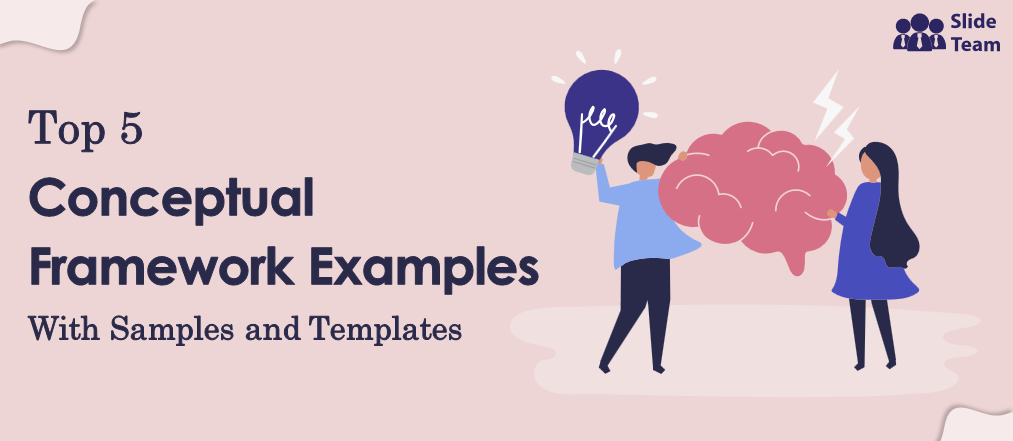
Tanmayi Arora
Wipro, a renowned IT company, has been leading the telecom infrastructure industry in attempts to improvise billing accuracy by nearly 19% and control revenue leakage with the help of a conceptual framework for pre-billing validation.
Earning revenue and drawing in sales can be a cup of tea for businesses with a researched framework for their marketing strategies and tricks.
A research framework needs thorough knowledge and ideas, on the basis of which, one can do well and deliver intendent results. But without clarity on the project’s purpose, one cannot proceed with the research framework. One must be aware of the variables and the relationship among them.
Hence, a conceptual framework is required to delve deeper into the understanding of any project.
A businessman always needs to research before creating a marketing plan, reaching the customers, setting the targets, and designing the shopper’s journey. SlideTeam provides customized PowerPoint Templates that can help you grow your sales and revenue in the longer run.
Check out our research plan templates to ensure that your research manifests into real-time goals.
This article will help you to work on all business processes with the help of conceptual framework templates.
An Analytical Tool
A conceptual framework is an analytic tool that you can use before conducting a study. Conceptual model is another word for it. You can jot down ideas while conducting a study and see the intended assumptions and expectations.
It is a visual representation of your research project where you can define the variables and the cognitive relationship among them in a clear manner.
What are the types of conceptual variables?
As stated above, you need to view the cause and effect of the ideas. Here are the types of conceptual variables which are used to design the framework of your research:
- Independent Variable : An independent variable is one that a researcher can control to create an effect on the dependent variable.
- Dependent Variable: The researcher tests the variables that are dependent on the independent variable.
- Moderating variables: These variables can change the effect that an independent variable can have on a dependent variable.
- Mediating variables : These are the mediators. They can interlink the dependent and independent variables. The mediating variables define the relationship between the dependent variables and independent variables.
EXAMPLE OF A CONCEPTUAL FRAMEWORK
While conducting any research, one must determine the cause-and-effect relationship. For that, one has to note down the expectations within a conceptual framework first and then they can divide the cause-and-effect relationship into variables
Let’s take the example of Lakme, a cosmetic brand, and say, the brand wants to earn more sales via its online store. Here are some of the proposed variables that can come under a conceptual model, i.e.
- The brand plans to earn 20 % more revenue via its online store. This is a dependent variable.
- The brand decides to do weekly social media promotions by giving a discount of 20% if the customer purchases within 24 hours by working on the UI of the online store. This would be an independent variable.
There is a relationship between the dependent and independent variables. If the brand improves the UI and offers a 20% discount and promotes the offer on social media, then it would be able to enhance the revenues.
START CREATING A CONCEPTUAL FRAMEWORK WITH SLIDETEAM’S CUSTOMIZED PPT TEMPLATES
Template 1: Framework for Customer Portfolio Management in B2B Sales
If you are a B2B company, you would require a complete portfolio of your customer. To enhance sales and revenue, a business must know its valuable and recurring customers through the portfolio’s analysis. One needs to prioritize their customers on profits, geography, activity, and so on. This customized and editable template would help you out in the process of customer portfolio management. Download it now.

DOWNLOAD THIS TEMPLATE
Template 2: Conceptual Framework of Cyberterrorism With Impact[LK1]
The following slide helps you to eliminate any risks for the target industry or economy. This template will help you set your goals and motivation to achieve them. It also presents the tools of attack, domain, and method of action. The Conceptual Framework of cyber terrorism with impact shows six stages of development. You can edit this slide and highlight all the information on network warfare, and psychological idealism. Get it now.
![research conceptual framework template Conceptual Framework of Cyberterrorism With Impact[LK1]](https://www.slideteam.net/wp/wp-content/uploads/2023/01/Conceptual-Framework-of-Cyberterrorism-With-ImpactLK1-784x441.jpeg)
DOWNLOAD THIS TEMPLATE
Template 3: Post Automation Conceptual Framework Logistics Improving Management Logistics Automation
The following PowerPoint Presentation Template would help you set up valuable stages for your business such as planning any marketing or sales process, outsourcing, tackling the resources, distributing them, and handling the reverse logistics . Provide detailed explanations to your clients regarding your management and other resources via this template. Click the link below to download

DOWNLOAD THIS TEMPLATE
Template 4 Supply Chain Management PowerPoint Presentation Conceptual Framework Slides
Supply Chain Management includes managing the processes to transform raw materials into final products. It involves management of supplying goods and services. These PowerPoint Slide Templates will help you streamline the business processes that will be involved in supplying the services to improvise customer value. Download it here.
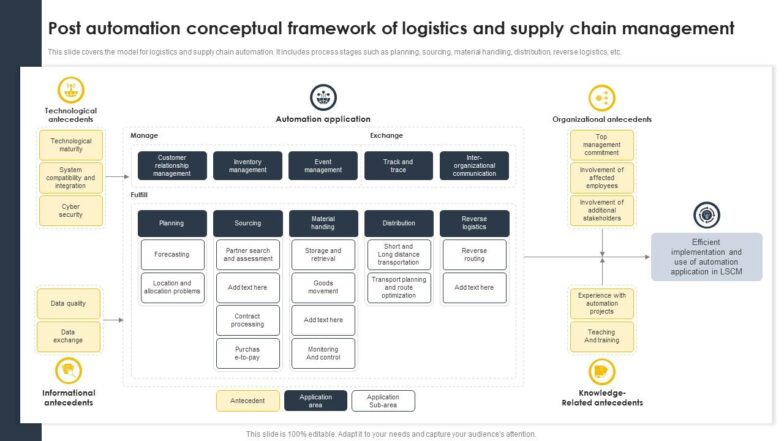
DOWNLOAD THIS TEMPLATE
Template 5 Safety Cost Conceptual Framework in Construction Project
The following PPT Layout focuses on the processes that are involved in construction project management. You can focus on the inputs, outputs, and activities of project management operations. Also, you can include the concepts such as the human resource action plan, safety cost models, creating and validating the safety cost structures, etc. The templates are easily downloadable and editable. You can lure your audience through these easy-to-use templates. Get it now.
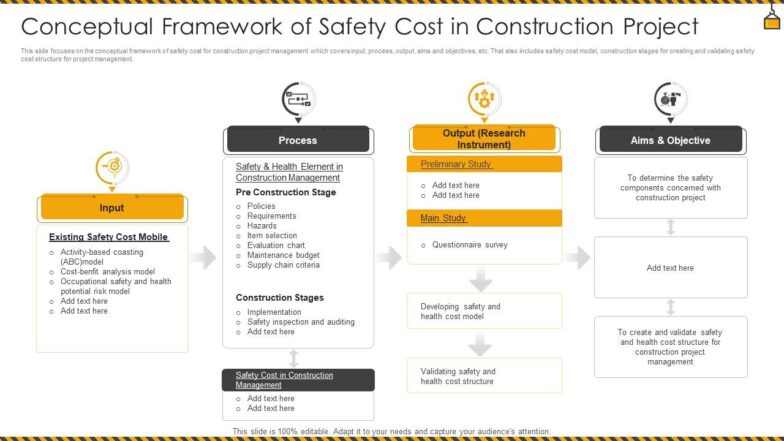
FAQs On CONCEPTUAL FRAMEWORK TEMPLATES
1. what is a conceptual framework and its purpose.
A conceptual framework is a tool to depict the relationship or cause & effect amongst the variables you want to undertake regarding any research. You can create your conceptual framework before integrating and collecting the data. The frameworks are usually shown in the form of visualizations.
The main purpose of the conceptual framework is to help you set out the targets to achieve the marketing goals for your brand. You can set out the assumptions and expectations for the variables. The objective and the purpose behind your research can be put together to map out the conclusions. You can measure, put variables, and watch out for the coherent dependency amongst them.
2. What are the three conceptual frameworks?
If you want to run your business for long [LK2], you have to work on the following facts while undertaking any conceptual framework.
- Market learning: In order to gain more sales and profits, you must learn about your customers’ preferences. You can hire certain market research agencies which can conduct surveys. That’s how one can know the current trends regarding customer preferences.
- Customer relationship management: This is an integral part of retaining customers. CRM involves practices to manage the customers’ interactions across channels such as chat, emails, social media, etc.
- Sales management: Creating a sales strategy is a must to drive revenue. It involves hiring people, conducting training for them, and motivating them to work toward a common goal.
3. What are the 3 variables in a conceptual framework?
There are three types of variables in conceptual frameworks -
- Moderating Variables: The moderating variables can change the relationship between the dependent and independent variables. These variables can boost, deteriorate, or make the relationship among the variables almost negligible.
- Mediating Variables: A mediating variable shows the relation between the dependent and independent variables. It also demonstrates reasons why there is a correlation between the variables at all. When one takes full account of the mediator’s effect, correlation among variables may fade away.
- Controlling Variables: These variables are kept constant in a study or marketing research. These variables might not be in direct relation with the objective but they could affect the outcome or conclusion.
4. How do you write a conceptual framework in research?
Conceptual framework in research can be in the form of written or visual representation.
These are the following steps one can follow while writing a conceptual framework in research:
- Choose the research question:- The research question you would select would help you know what you want to discover so that your research can have a clear and precise focus. The conceptual framework is, therefore, necessary before you collect all relevant data. This is how you can first jot down variables and discover a correlation between them.
- Find out the dependent and independent variables:- The second step is to check the cause-effect relationship among the variables
- View the cause-and-effect relationship:- Once you have noted down the research question and the variables, the next step is to set the assumptions of the cause-effect relationship among the variables.
- Check out other variables that influence:- Point out the other variables that can influence the research. These could be moderating and controlling variables.
Related posts:
- Top 30 Digital Marketing Templates to Track your Campaigns
- Maximize your ROI with these Top 25 Marketing Deck PowerPoint Templates
- [Updated 2023] 50 Best Company Presentation Templates To Ace The Corporate Ladder
- Top 25 Food & Agriculture PowerPoint Templates to Create Delicious Looking Presentations
Liked this blog? Please recommend us

Top 5 Competitor Analysis Framework Templates with Samples and Examples

Top 10 Leadership Frameworks with Samples and Examples

Top 10 Digital Transformation Framework Templates with Samples and Examples

Top 10 Competency Framework Templates With Samples And Examples
This form is protected by reCAPTCHA - the Google Privacy Policy and Terms of Service apply.

Digital revolution powerpoint presentation slides

Sales funnel results presentation layouts
3d men joinning circular jigsaw puzzles ppt graphics icons

Business Strategic Planning Template For Organizations Powerpoint Presentation Slides

Future plan powerpoint template slide

Project Management Team Powerpoint Presentation Slides

Brand marketing powerpoint presentation slides

Launching a new service powerpoint presentation with slides go to market

Agenda powerpoint slide show

Four key metrics donut chart with percentage

Engineering and technology ppt inspiration example introduction continuous process improvement

Meet our team representing in circular format

- Activity Diagram (UML)
- Amazon Web Services
- Android Mockups
- Block Diagram
- Business Process Management
- Chemical Chart
- Cisco Network Diagram
- Class Diagram (UML)
- Collaboration Diagram (UML)
- Compare & Contrast Diagram
- Component Diagram (UML)
- Concept Diagram
- Cycle Diagram
- Data Flow Diagram
- Data Flow Diagrams (YC)
- Database Diagram
- Deployment Diagram (UML)
- Entity Relationship Diagram
- Family Tree
- Fishbone / Ishikawa Diagram
- Gantt Chart
- Infographics
- iOS Mockups
- Network Diagram
- Object Diagram (UML)
- Object Process Model
- Organizational Chart
- Sequence Diagram (UML)
- Spider Diagram
- State Chart Diagram (UML)
- Story Board
- SWOT Diagram
- TQM - Total Quality Management
- Use Case Diagram (UML)
- Value Stream Mapping
- Venn Diagram
- Web Mockups
- Work Breakdown Structure
Thesis Conceptual Framework
Outline of how you plan to conduct the research for your thesis with Creately's example. Use the template to easily visualize framework with Creately visual workspace.
You can easily edit this template using Creately. You can export it in multiple formats like JPEG, PNG and SVG and easily add it to Word documents, Powerpoint (PPT) presentations, Excel or any other documents. You can export it as a PDF for high-quality printouts.
- Flowchart Templates
- Org Chart Templates
- Concept Map Templates
- Mind Mapping Templates
- WBS Templates
- Family Tree Templates
- Network Diagram Templates
- SWOT Analysis Templates
- Genogram Templates
- Activity Diagram
- Class Diagram
- Collaboration Diagram
- Component Diagram
- Data Flow Diagrams(YC)
- Deployment Diagram
- Object Diagram
- Sequence Diagram
- State Chart Diagram
- Use Case Diagram
Related Templates

Conceptual Framework
What do you think of this template.

Product details
A Conceptual Framework is a visual representation that helps to illustrate the expected relationship between cause and effect in a financial context.
It is also called a Conceptual Model or research model. Different variables and the assumed relationships between those variables are included in the model and reflect the expectations.
This framework is a tool that is used before to a study. This makes a Conceptual Framework an analytical tool. It is used to make conceptual distinctions and bring together different ideas. Strong Conceptual Frameworks lead to actual realisation of the intended objective.
In a Conceptual Model, the relationships are clearly defined between the different variables and their relationship to each other. Typically, the model is prepared before actual research takes place.
In addition, the type of research determines whether it is wise and useful to work with a Conceptual Framework. In testing research, the use of a Conceptual Framework is customary.
Based on hypotheses, a certain idea can be shown. The basis of testing research is to demonstrate the cause-effect relationship, which is also reflected in the Conceptual Framework. In testing research, one works with specific expectations about cause and effect relationships, which are displayed in the schematic model.
Nevertheless, the model is also suitable for exploratory research. This often consists of broadly defined concepts instead of specifically defined variables. In this type of research, the specific relationships are identified afterwards and the variables are directly measurable and formulated fairly concretely.
Working with a Conceptual Model has various advantages. First, the user is forced to think carefully about the variables and give them precise descriptions.
In addition, the guidelines help you to reach a final result. The standards that are determined in advance will be consistent with this framework, so that everyone who has the variables knows exactly what is expected.
Finally, the purpose of the conceptual framework is to reveal the gaps in knowledge. If the findings show that some aspects of the phenomenon have not been explored or well understood, then that is where you come in. You have found that elusive research gap, which your study can help address or resolve. That is the beauty of having a conceptual framework ready at hand.
Marketers can use this template when preparing a marketing strategy. You can present cause-and-effect relationships when conducting advertising campaigns through various advertising channels. This template will be helpful to researchers when preparing a research report.
University professors can use this template when preparing courses on building conceptual models or identifying cause and effect relationships.
Conceptual Framework is a professional and modern template that contains five stylish and fully editable slides. You can change the type and size of the font, color and position of the infographic yourself. This template will be useful for project managers, marketers, researchers. Conceptual Framework template will complement your old presentations and will be a worthy addition to your collection of professional presentations.
Related Products
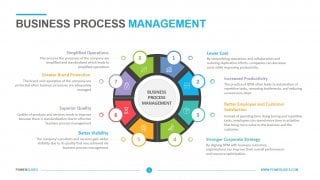
Business Process Management
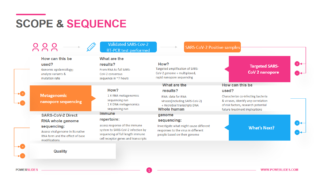
Scope and Sequence

Target Operating Model

Vertical vs Horizontal Integration
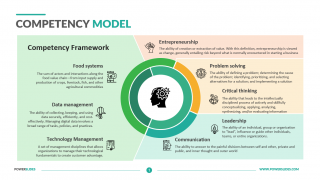
Competency Model
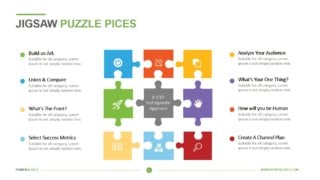
Jigsaw Puzzle Pieces
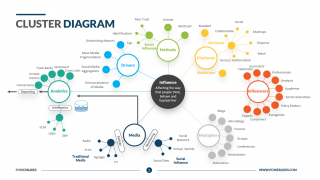
Cluster Diagram
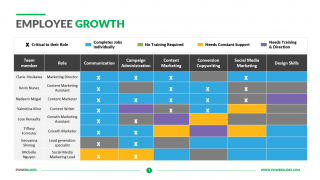
Employee Growth
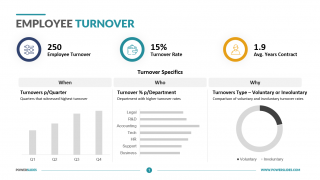
Employee Turnover
You dont have access, please change your membership plan., great you're all signed up..., verify your account.
PowerSlides.com will email you template files that you've chosen to dowload.
Please make sure you've provided a valid email address! Sometimes, our emails can end up in your Promotions/Spam folder.
Simply, verify your account by clicking on the link in your email.
- Sample Research
FREE 10+ Research Framework Samples & Templates in MS Word | PDF

In research, the research design statement for its framework aligns the essence of the research paper or study to provide insights that the writer needs, whether they are solving a complex organizational problem or contributing to a theory. The framework provides the writer with a structure to manage the development of an aligned and consistent research design. With a framework, an individual can effectively build or construct something, and is often used in different fields, from web development proposals to quantitative research and qualitative research proposal .
Research Framework
Free 10+ research framework samples & templates, 1. research framework template, 2. research design framework, 3. research evaluation framework, 4. e-interview research framework template, 5. lean research framework, 6. research conceptual framework, 7. research framework overview template, 8. research methodology & analysis framework, 9. user research framework template, 10. research framework & methodology, 11. sample research framework template, what is a research framework, how to use a research framework, step 1: write down your observations, step 2: make your research questions, step 3: determine the most effective method, step 4: analyze the collected data, what are the benefits of utilizing research frameworks, what are the components of a research design framework, what is a theoretical framework.
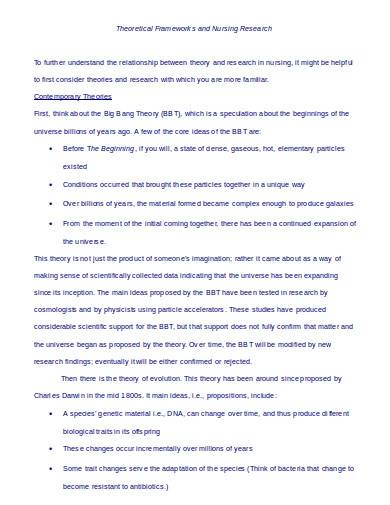
Size: 22 KB
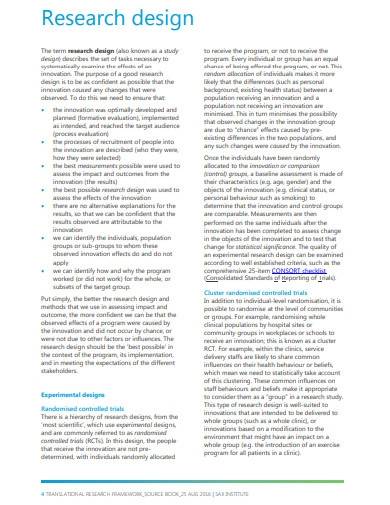
Size: 212 KB
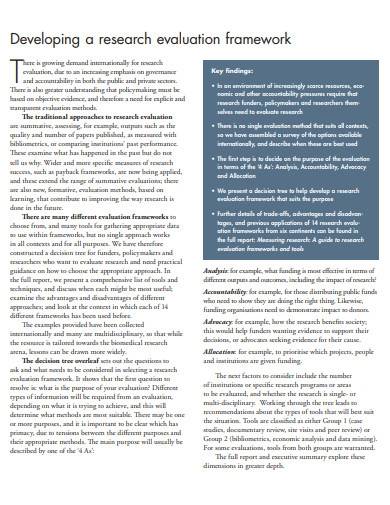
Size: 215 KB
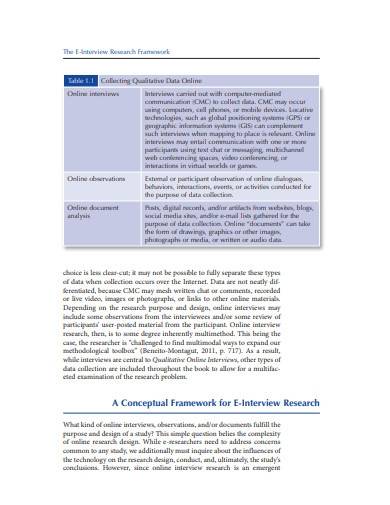
Size: 1007 KB
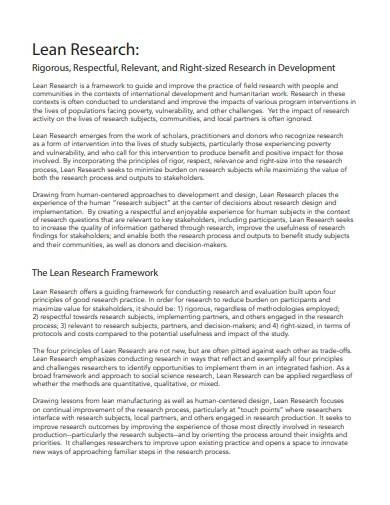
Size: 273 KB
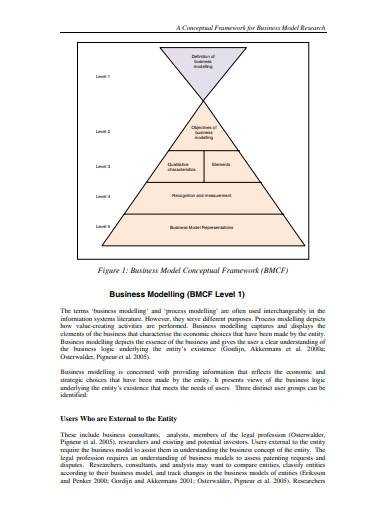
Size: 163 KB
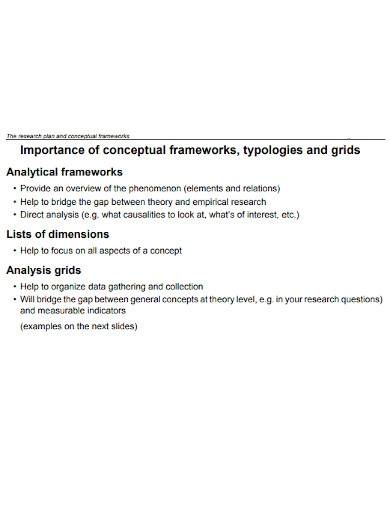
Size: 479 KB
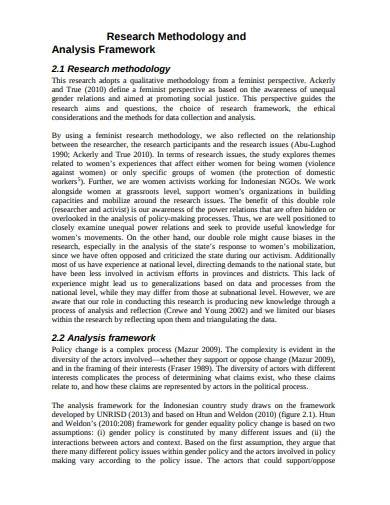
Size: 196 KB
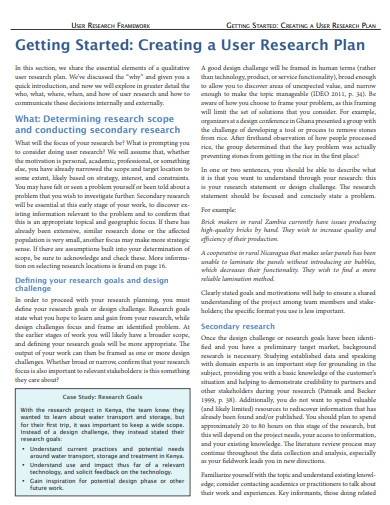
Size: 308 KB

Size: 919 KB
A research framework is the accurate representation of the outline or layout of a research project proposal or development plan. With a framework, researchers or writers can identify the important aspects or critical areas of the subject matter they are studying about. It also enables them to determine the appropriate and relevant research objectives and questions that will help them in the development of their research.
To provide a guideline or a roadmap for research activities, a research framework is used by researchers to guide them through relevant conversations that surround their research as well as to determine the appropriate approach and method to use in what situation. A framework not only helps in planning research activities but also enables writers to prioritize the effort of their research team and emphasizes how to effectively spend their time.
With your established framework, take time to observe your research surroundings. You can write down notes of various indicators that can reveal the important factors of your research. You may also notice unusual activities that will require you further analysis as well as connections between matters that your existing information did not cover.
After taking notes of essential observations, develop your research questions. In this step, make sure that the questions you’ve formulated will grab the attention and interest of your audience. However, you also have to make sure that your questions are answerable with the given resources and time.
After formulating your research questions and creating the objectives of the research study plan , you can now determine the method you will use to collect relevant data. Some of the research designs you can use include a case study, open-label, cross-sectional, parallel design, and a case-control design.
Once you have collected all relevant data and information, you can utilize statistical analysis to think of the best solution and conclusion for the research. After you have concluded your research paper, you can now present your findings to your target audience.
With research frameworks, you can obtain timely knowledge, whether you are performing a study for a marketing research proposal or a nursing research proposal . You can also determine the gaps between data, and develop a research action plan or strategy.
There are nine components of a research design framework which are the problem statement, purpose statement, research questions, conceptual framework, literature review , overall approach, data collection, data analysis, and conclusions.
A theoretical framework refers to the structure of a research study that supports a theory. It consists of concepts with their corresponding definitions as well as the theories used for a certain study and their understanding that is relevant to the topic of the research paper.
A research framework is the structure of the outline of a research paper that the researcher or writer follows to ensure the development and progress of their study on the right path. This framework helps researchers to identify the areas they need to conduct further research as well as enables them to develop relevant questions and objectives for their study.
Related Posts
Free 10+ quantitative research report samples & templates in ..., free 8+ market research samplesin pdf ms words | apple pages, free 7+ sample research reports in pdf, free 11+ sample research plan templates in ms word pdf, free 11+ research plan samples in pdf ms word, free 14+ sample research proposals in pdf ms word, free 8+ table of content templates in ms word, free 33+ action plan samples in pdf, free 9+ quantitative research samples & templates in ms word ..., sample case analysis template, free 10+ liquidity risk management samples in pdf doc, sample consulting report, free 8+ terms and conditions samples in pdf ms word, free 20+ research paper outlines in pdf ms word, free 27+ research paper formats in pdf, free 10+ research ethics samples & templates in ms word pdf, free 10+ academic research report samples & templates in pdf, free 30+ research paper samples in pdf.

Conceptual Framework in Research Template
404 Not found
404 Not found

IMAGES
VIDEO
COMMENTS
Conceptual Framework Template #2: Input-Process-Output (IPO) Model Conceptual Framework Template #3: Concept Map ... Presented below is the concept map for the research's conceptual framework: 5. Explain Your Conceptual Framework in Narrative Form. Provide a brief explanation of your conceptual framework. State the essential variables, their ...
Developing a conceptual framework in research. Step 1: Choose your research question. Step 2: Select your independent and dependent variables. Step 3: Visualize your cause-and-effect relationship. Step 4: Identify other influencing variables. Frequently asked questions about conceptual models.
A conceptual framework is a structured approach to organizing and understanding complex ideas, theories, or concepts. It provides a systematic and coherent way of thinking about a problem or topic, and helps to guide research or analysis in a particular field. A conceptual framework typically includes a set of assumptions, concepts, and ...
The conceptual framework can be created in the form of a flowchart, mind map, concept map or process diagram to display your Hypothesis and the chain of variables. Use shape data to store in-depth information about each variable and their influence. When presenting the conceptual framework, include a section to display your research methodology.
A conceptual framework in research is used to understand a research problem and guide the development and analysis of the research. It serves as a roadmap to conceptualize and structure the work by providing an outline that connects different ideas, concepts, and theories within the field of study. A conceptual framework pictorially or verbally ...
an example conceptual framework memo that details how a researcher describes their conceptual framework. CONCEPTUAL FRAMEWORKS . IN RESEARCH. A conceptual framework lives at the center of an empirical . study. The conceptual framework serves as a guide and ballast to research (Ravitch & Riggan, 2016), functioning as an integrating
A conceptual framework helps researchers create a clear research goal. Research projects often become vague and lose their focus, which makes them less useful. However, a well-designed conceptual framework helps researchers maintain focus. It reinforces the project's scope, ensuring it stays on track and produces meaningful results.
Steps to Developing the Perfect Conceptual Framework. Pick a question. Conduct a literature review. Identify your variables. Create your conceptual framework. 1. Pick a Question. You should already have some idea of the broad area of your research project. Try to narrow down your research field to a manageable topic in terms of time and resources.
A conceptual framework illustrates the expected relationship between your variables. It defines the relevant objectives for your research process and maps out how they come together to draw coherent conclusions. Tip. You should construct your conceptual framework before you begin collecting your data.
A conceptual framework is a hierarchical representation of the relationships between variables under study. It can be created in a number of ways, but is most commonly displayed as a tree. The nodes at the top of the tree represent the variables being studied and may include terms such as "Condition", "Variable", and "Main Effect".
The evolution of a research idea into a study design is useful for understanding the impact that developing a conceptual framework has on this work. Adding the academic structure required to go from idea to fully realized conceptual framework is integral to a sound study. Going into the
Conceptual Framework in Qualitative Research . Again, you can pursue the same step-by-step guide discussed previously go create a conceptual framework for qualitative research. However, note that to should avoid using one-way arrows since they may indicate cause. Qualitative exploration impossible prove causation since it uses only descriptive ...
Conceptual Framework Template #1: Independent-Dependent Variable Model ... Presented below is the concept mapping to the research's conceptual framework: 5. Explain Your Conceptual Framework in Narrative Form. Provide a brief explanation of your conceptions framework. State the essential variables, their relationship, and the research outcome.
Here are the types of conceptual variables which are used to design the framework of your research: Independent Variable: An independent variable is one that a researcher can control to create an effect on the dependent variable. Dependent Variable: The researcher tests the variables that are dependent on the independent variable.
Thesis Conceptual Framework. Use Creately's easy online diagram editor to edit this diagram, collaborate with others and export results to multiple image formats. Outline of how you plan to conduct the research for your thesis with Creately's example. Use the template to easily visualize framework with Creately visual workspace.
A conceptual framework is a tool that researchers use to guide their investigation; it is a collection of concepts used to shape the study, sort of like a map that includes the research question, the literature review, methodology, and data analysis. A conceptual framework guides researchers' data collecting and analysis.
Your best resource for free editable conceptual framework diagram templates! Find more inspiration about conceptual framework, and join other users by sharing your own. ... Conceptual Framework in Research Template. Community Helper. 780 171 0 Edit online Conceptual Framework about Water Filtration. BawBaw DG. 657 258 0 Edit online ...
Published on 2022-07-06. Download. Download EdrawMax. Edit Online. This conceptual framework in research is commonly used to refer to the overall structure that shapes a research project. A conceptual framework in research is similar to a road map for your study, assisting you in visualizing and carrying out your research project.
This template will be helpful to researchers when preparing a research report. University professors can use this template when preparing courses on building conceptual models or identifying cause and effect relationships. Conceptual Framework is a professional and modern template that contains five stylish and fully editable slides.
FREE 10+ Research Framework Samples & Templates. 1. Research Framework Template. 2. Research Design Framework. 3. Research Evaluation Framework. 4. E-Interview Research Framework Template.
Download. Download EdrawMax. Edit Online. For any scientific or research study, it is important to establish a clear, comprehensive conceptual framework. This outlines the key concepts of the research, such as topics and objectives, as well as how they are related and the algorithms used to gather data. A good template for creating a conceptual ...
In this conceptual framework, the related between the signs and variables of our study is presented. After is conceptual framework implies that your research provides empirical evidence to proven the relationship betw variables. This is the type of conceptual framework which is ordinary used in exploration studies. 3. Mathematical Property
AVAILABLE 10+ Research Framework Templates in PDF | MS Word. A research framework contents of ideas, accompanied the definitions, and existing hypothesis/speculations that are utilized for your specific examine. The hypothetical system must exhibit comprehension of hypotheses and beliefs that apply to aforementioned subject of your examination paper and that willingness relate items up the ...